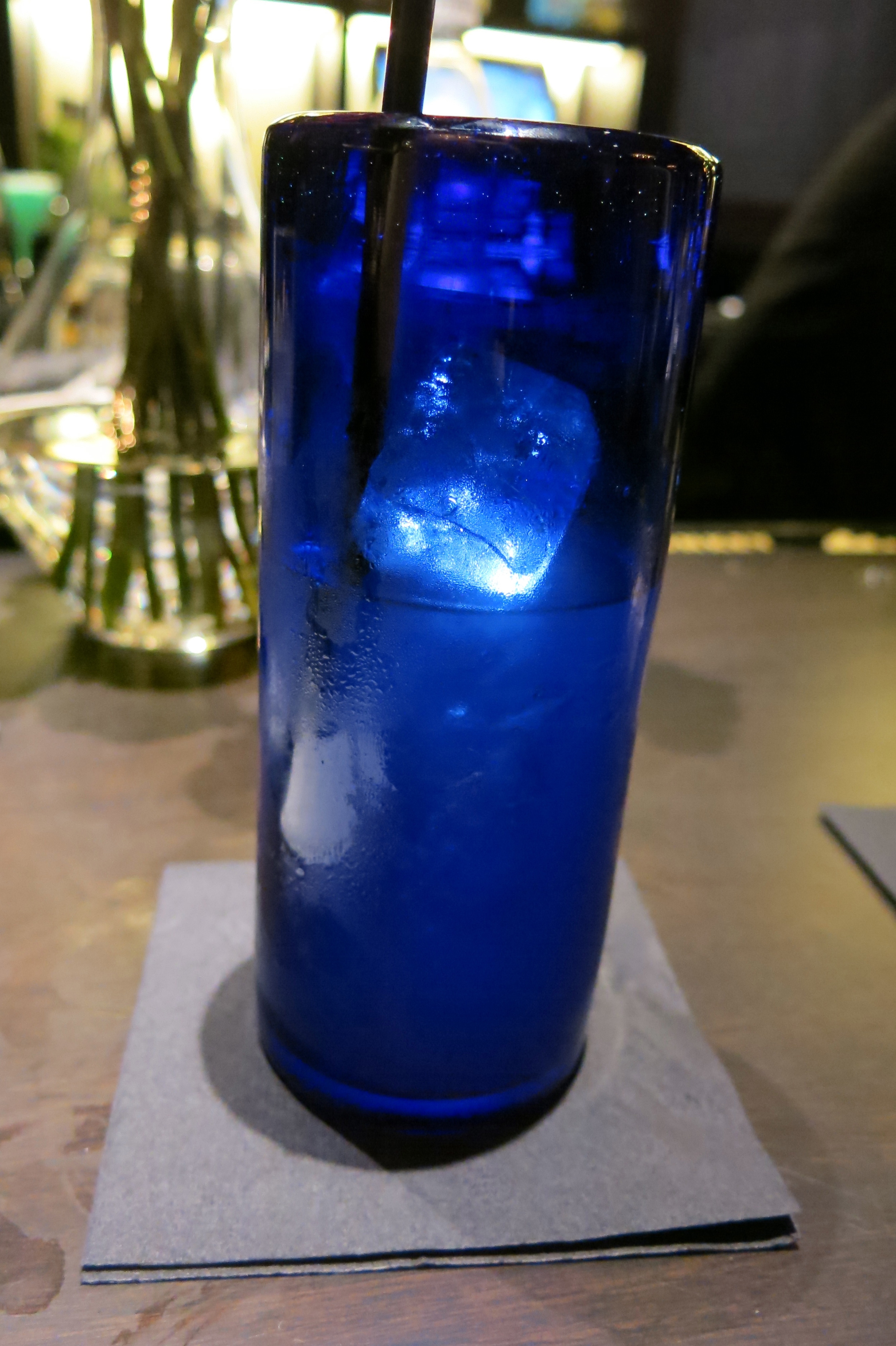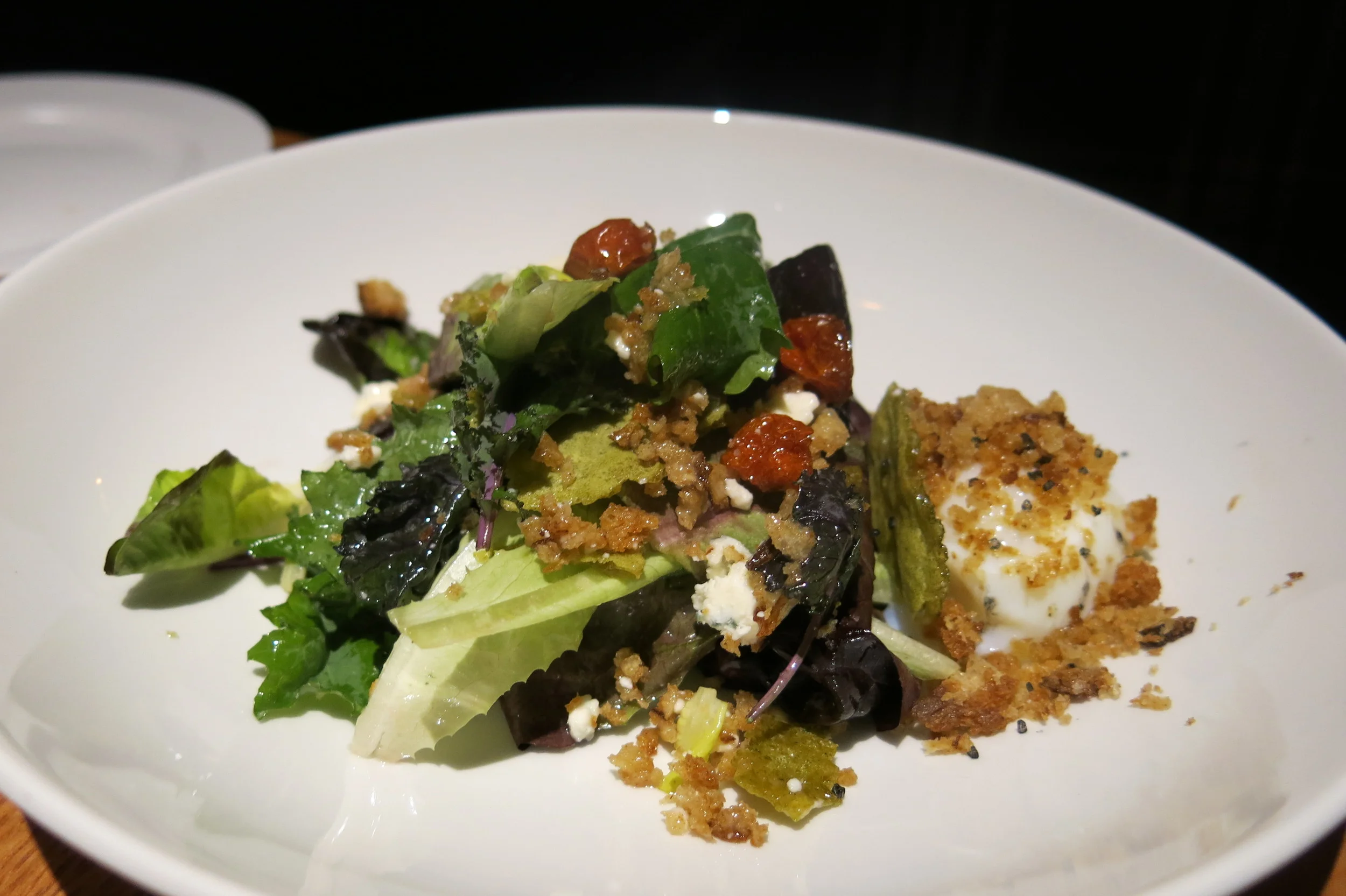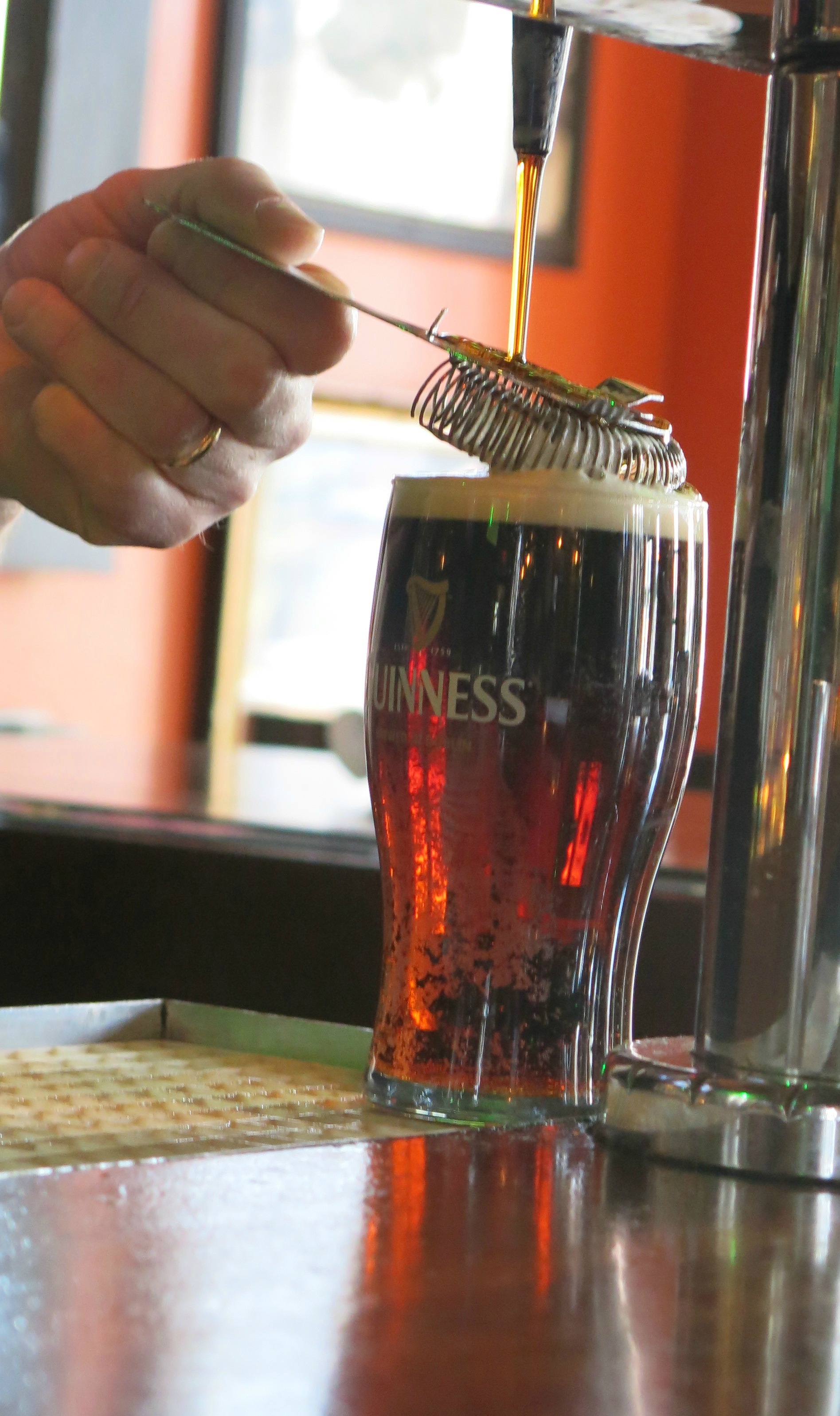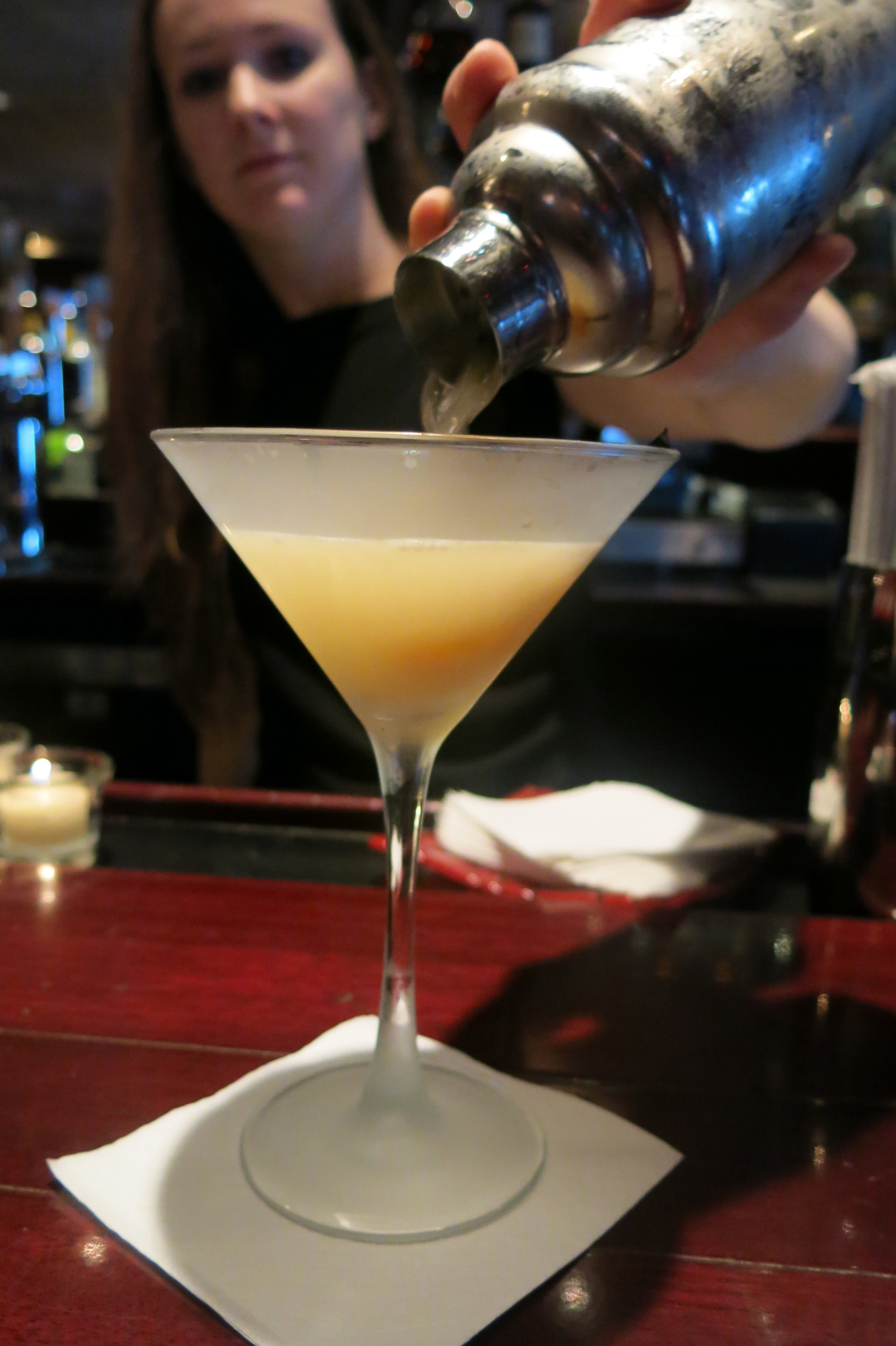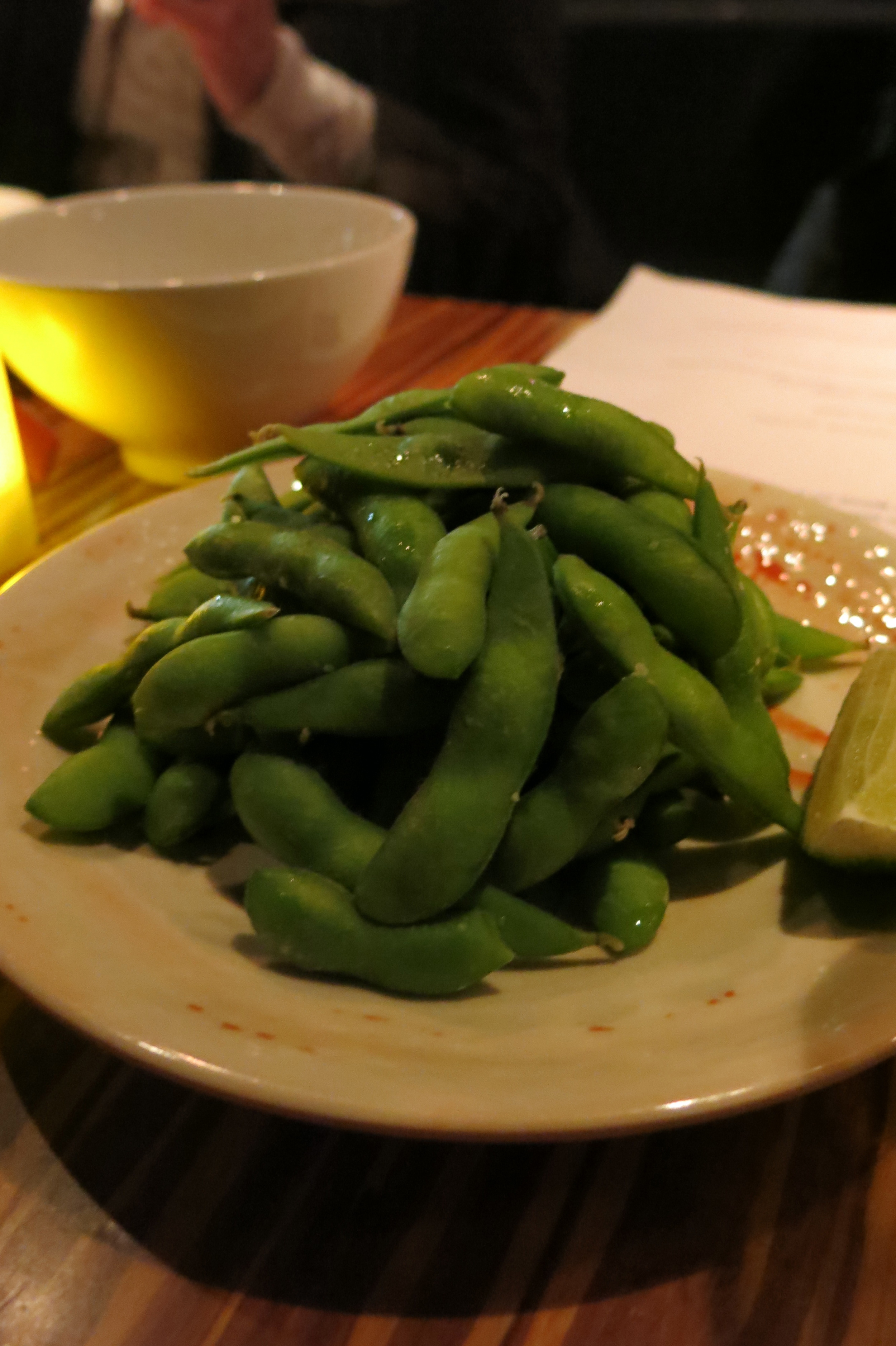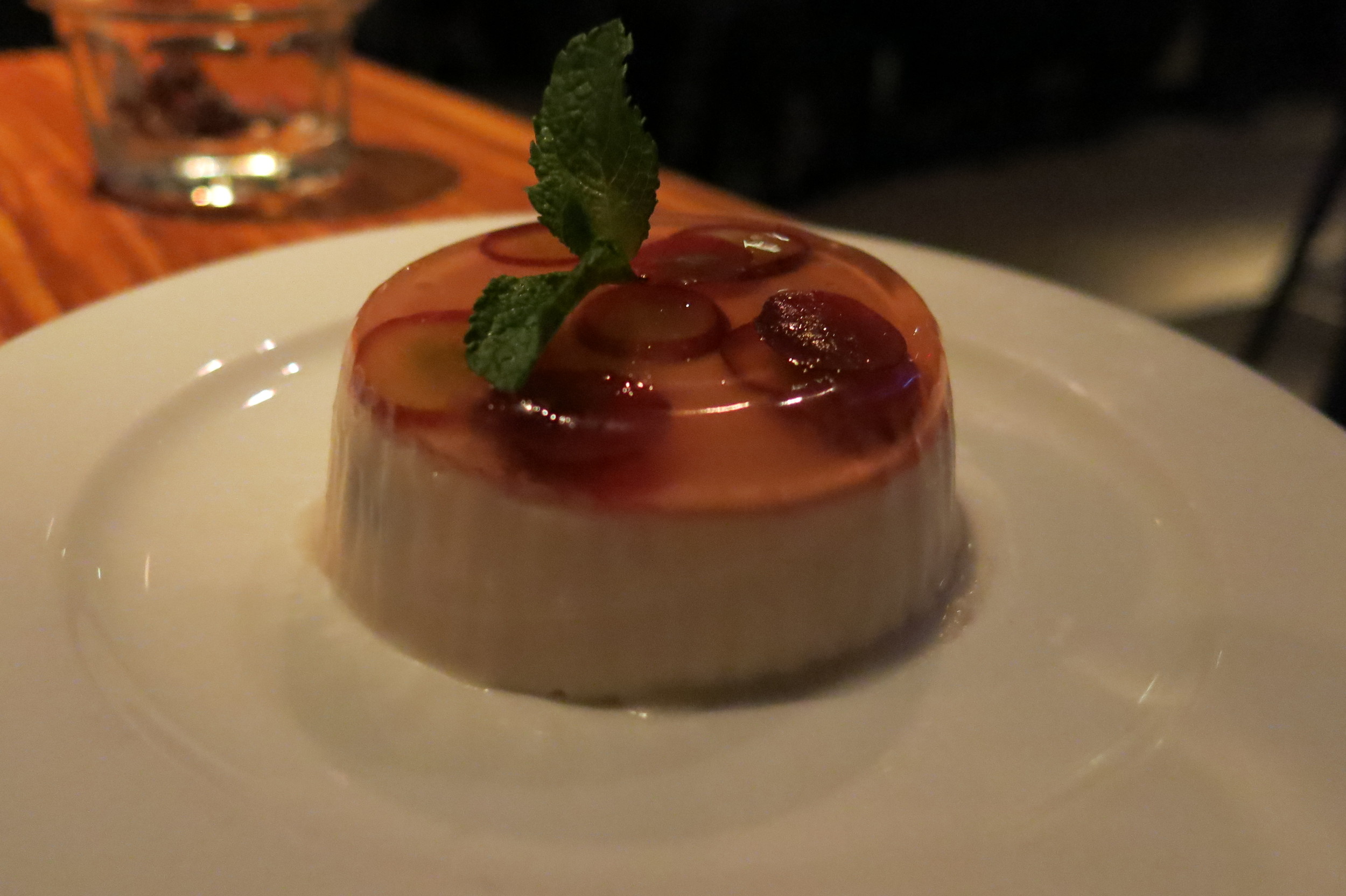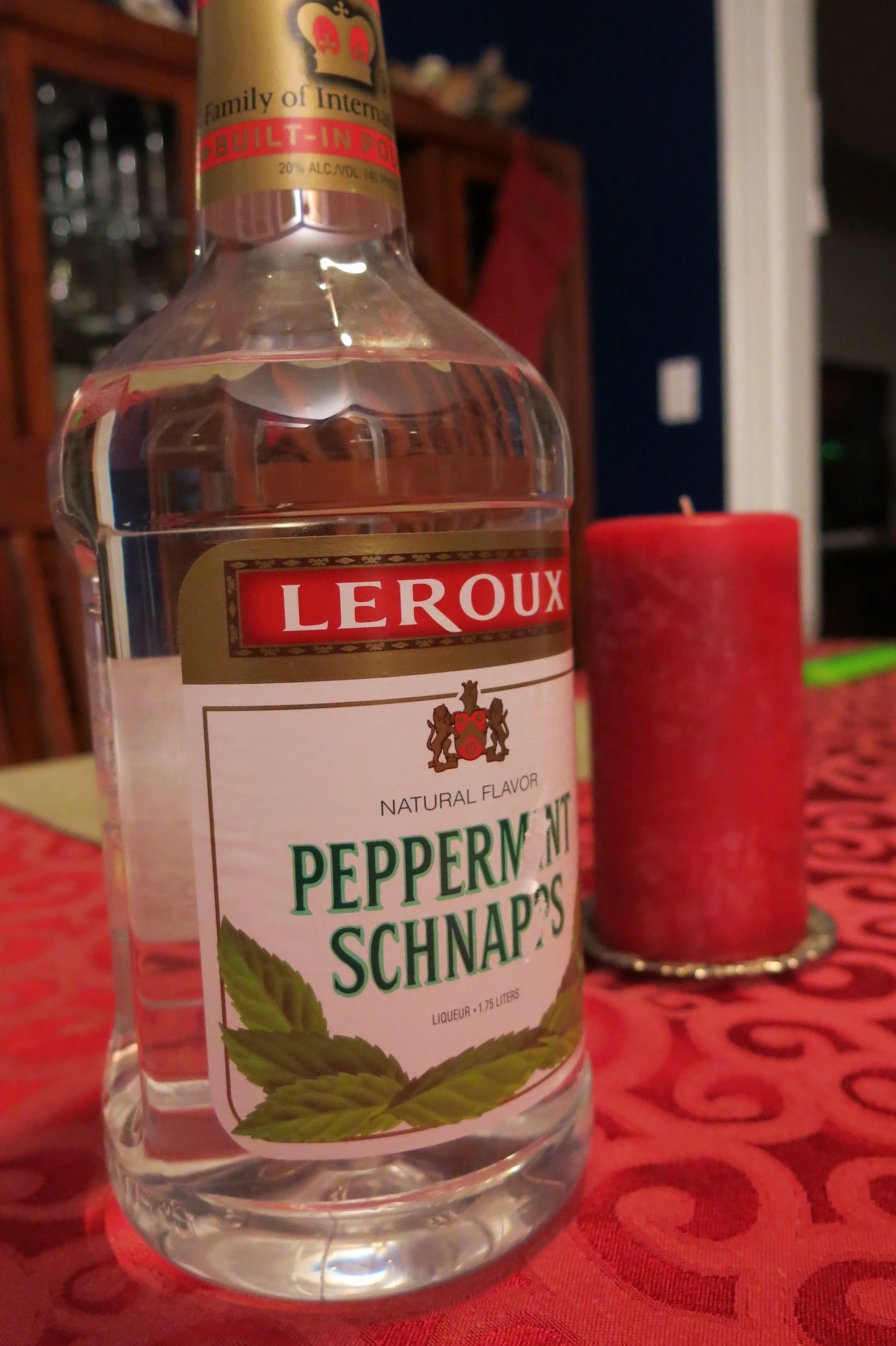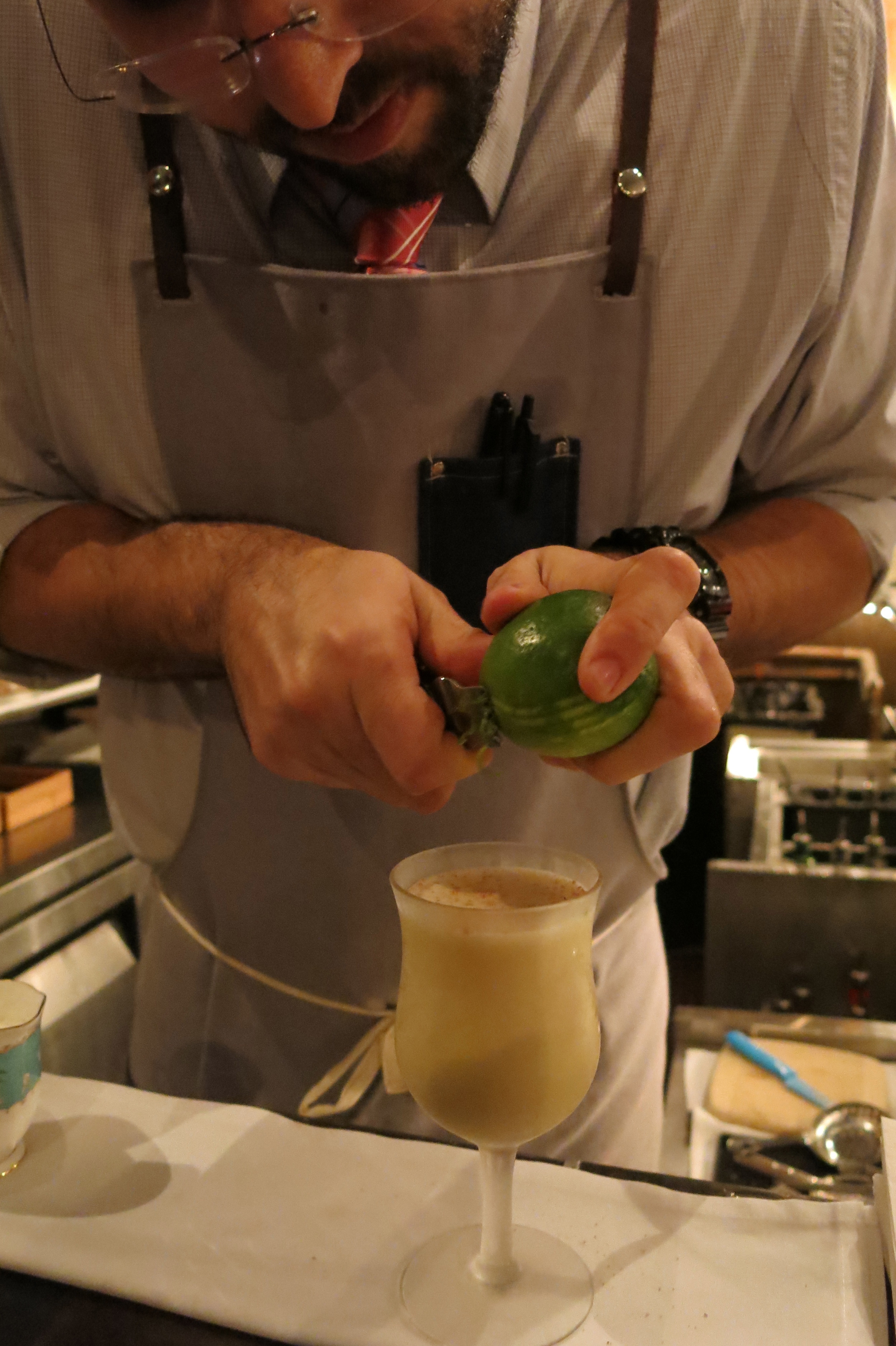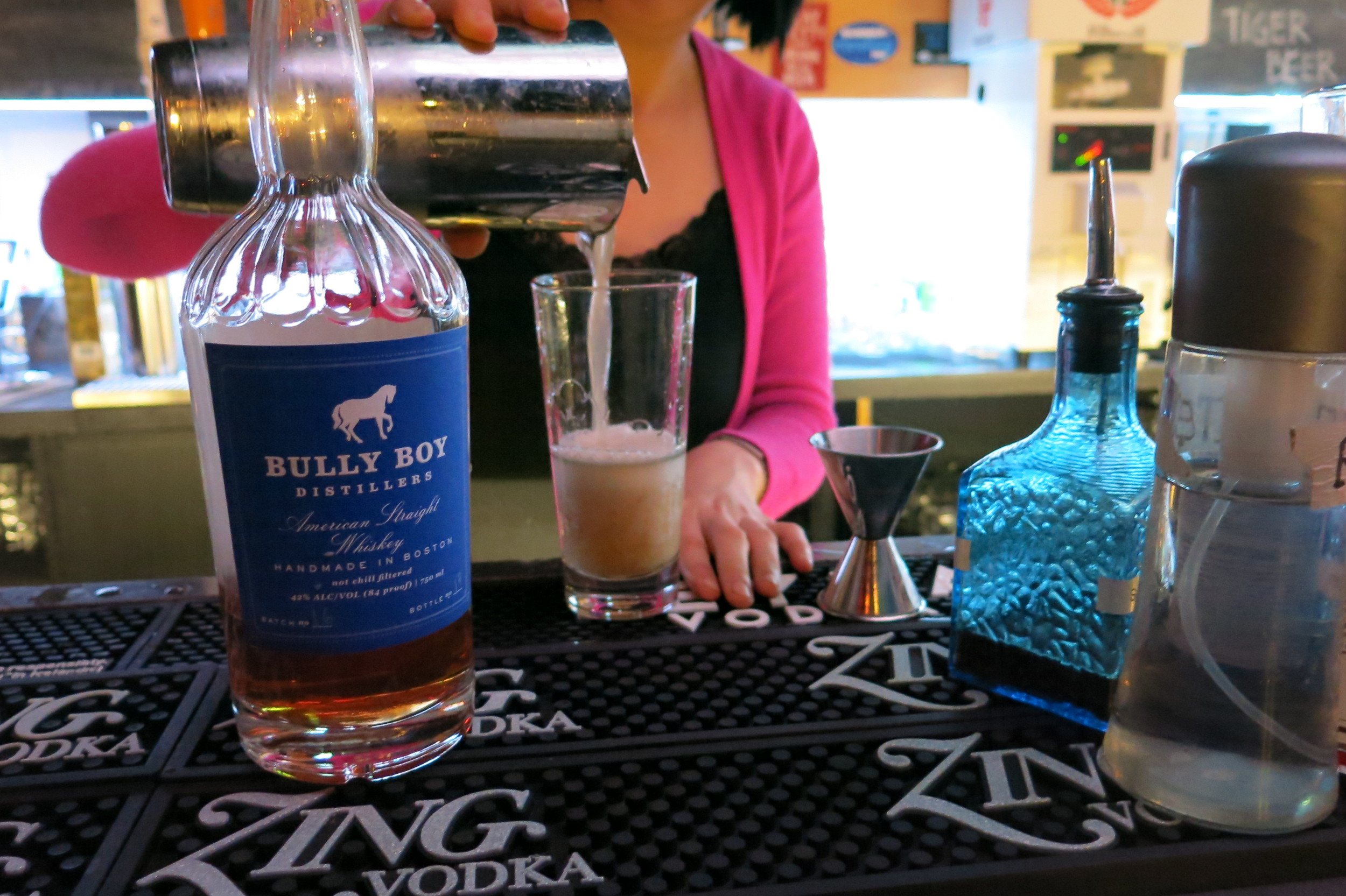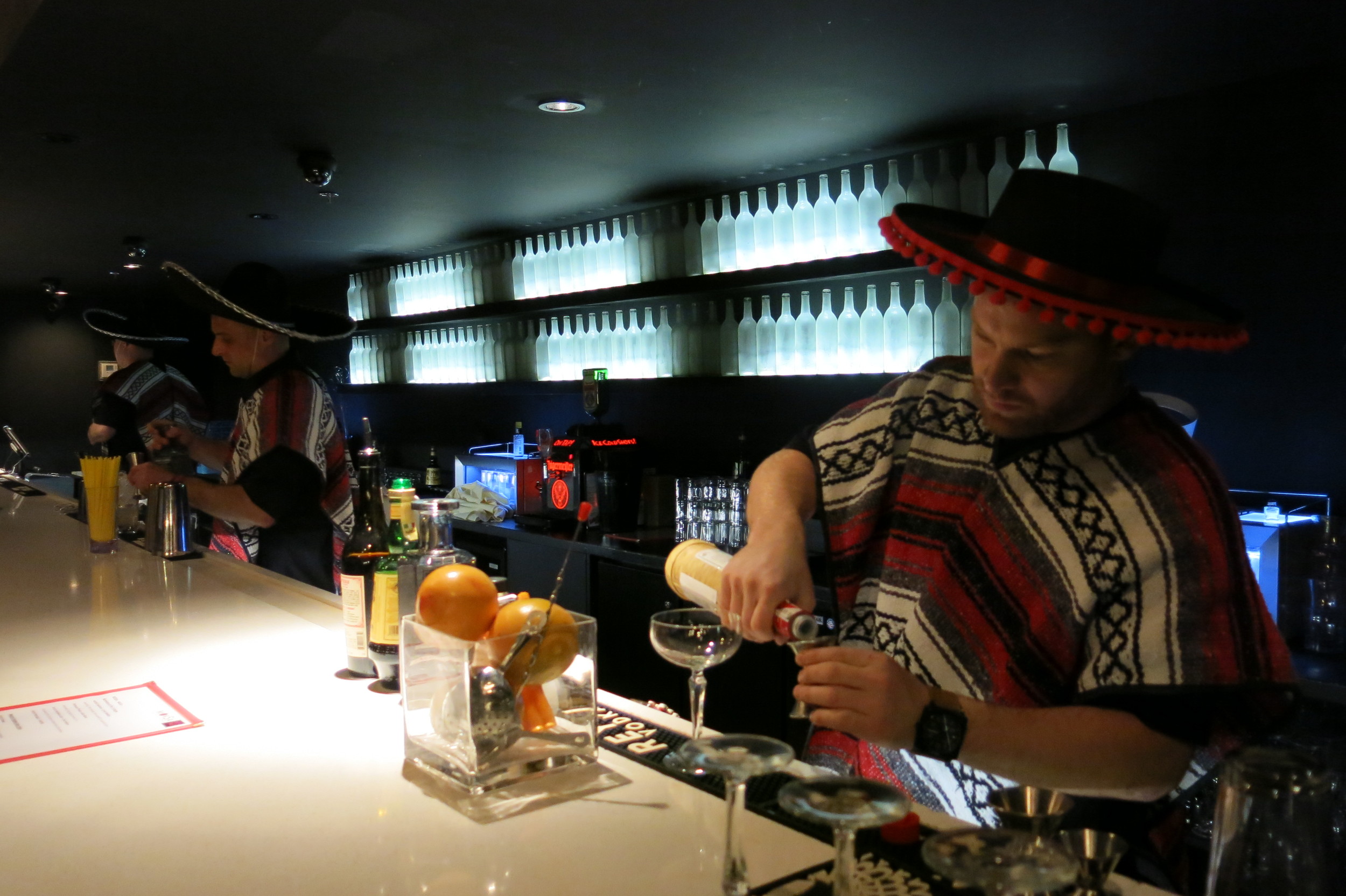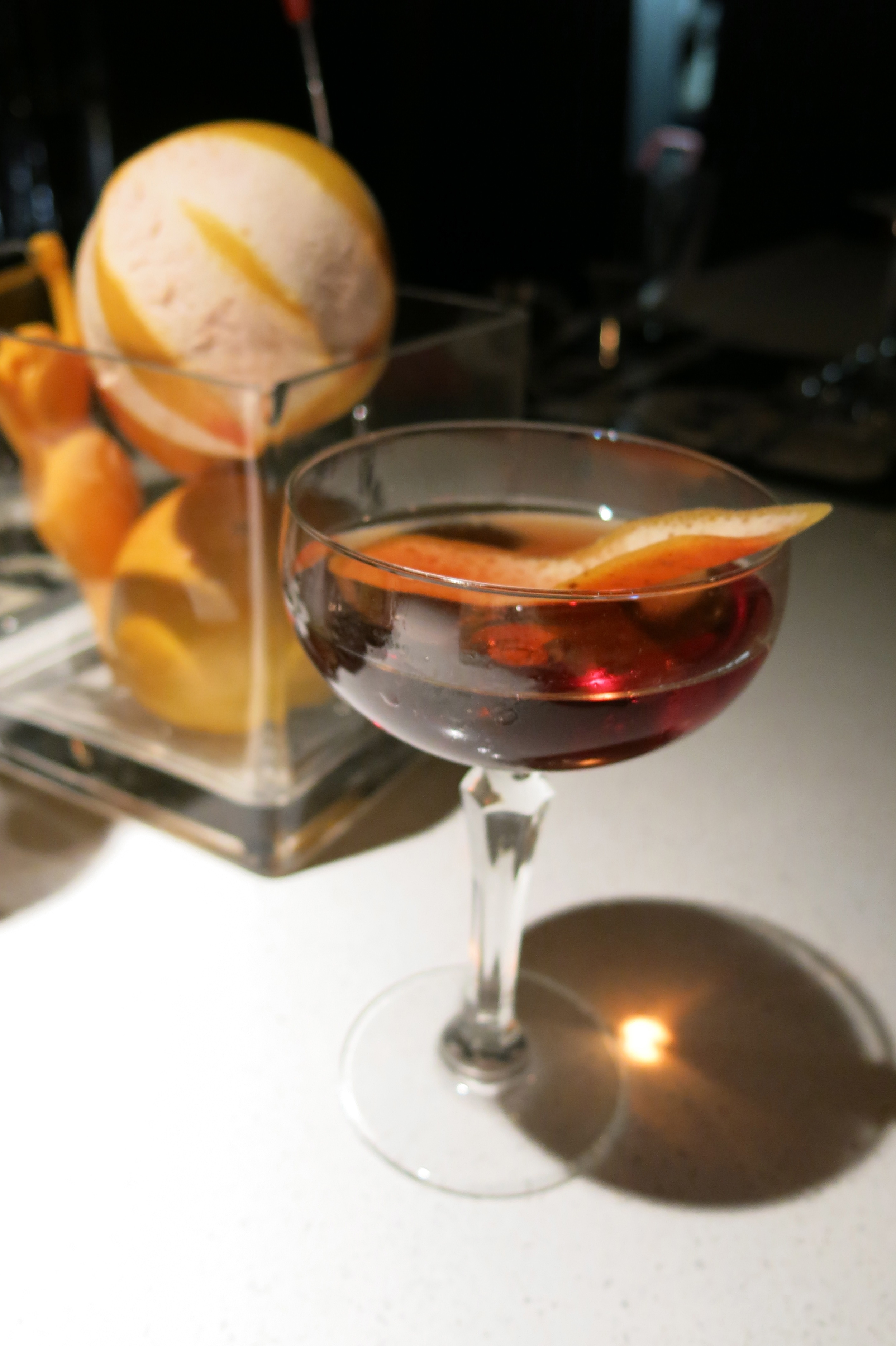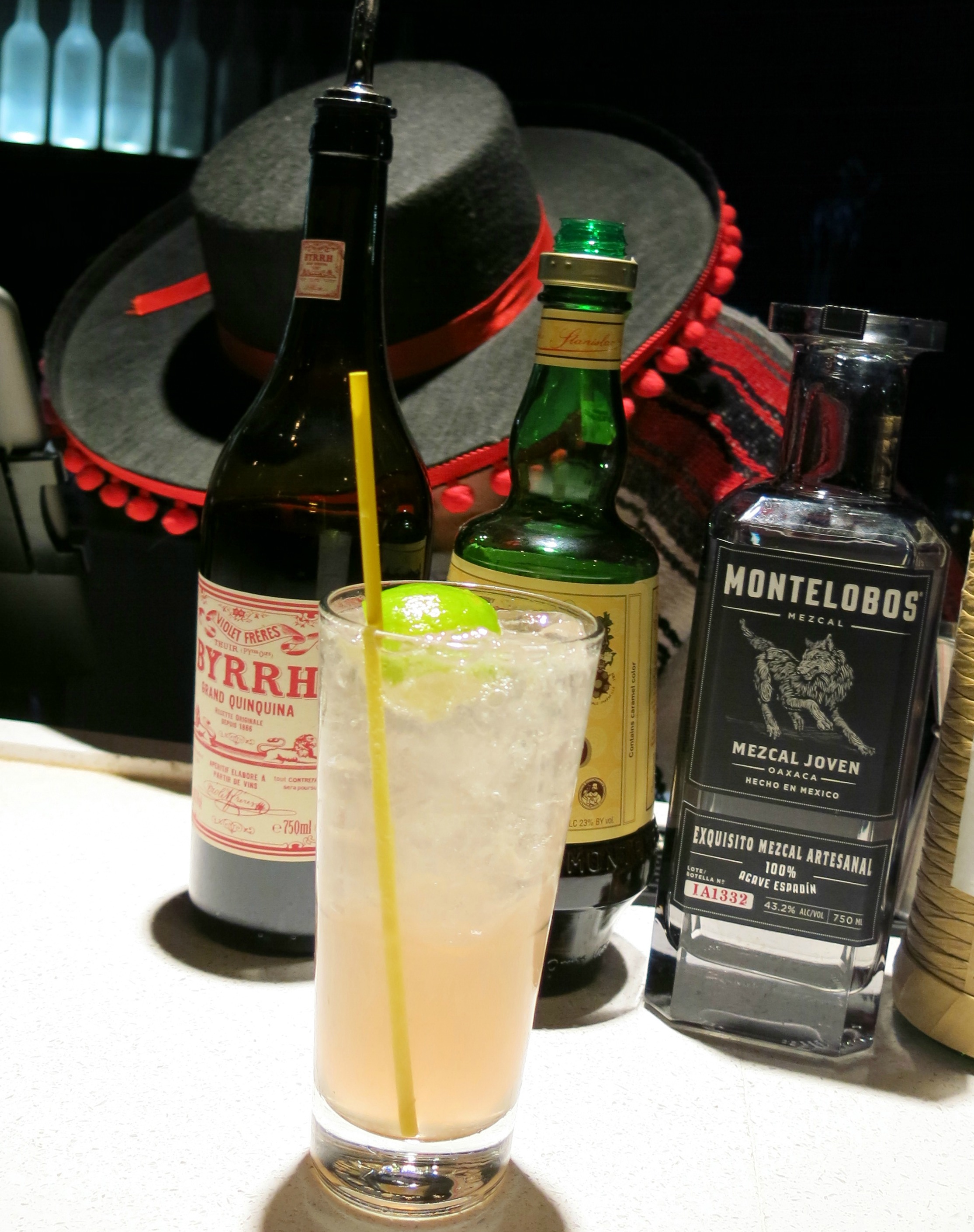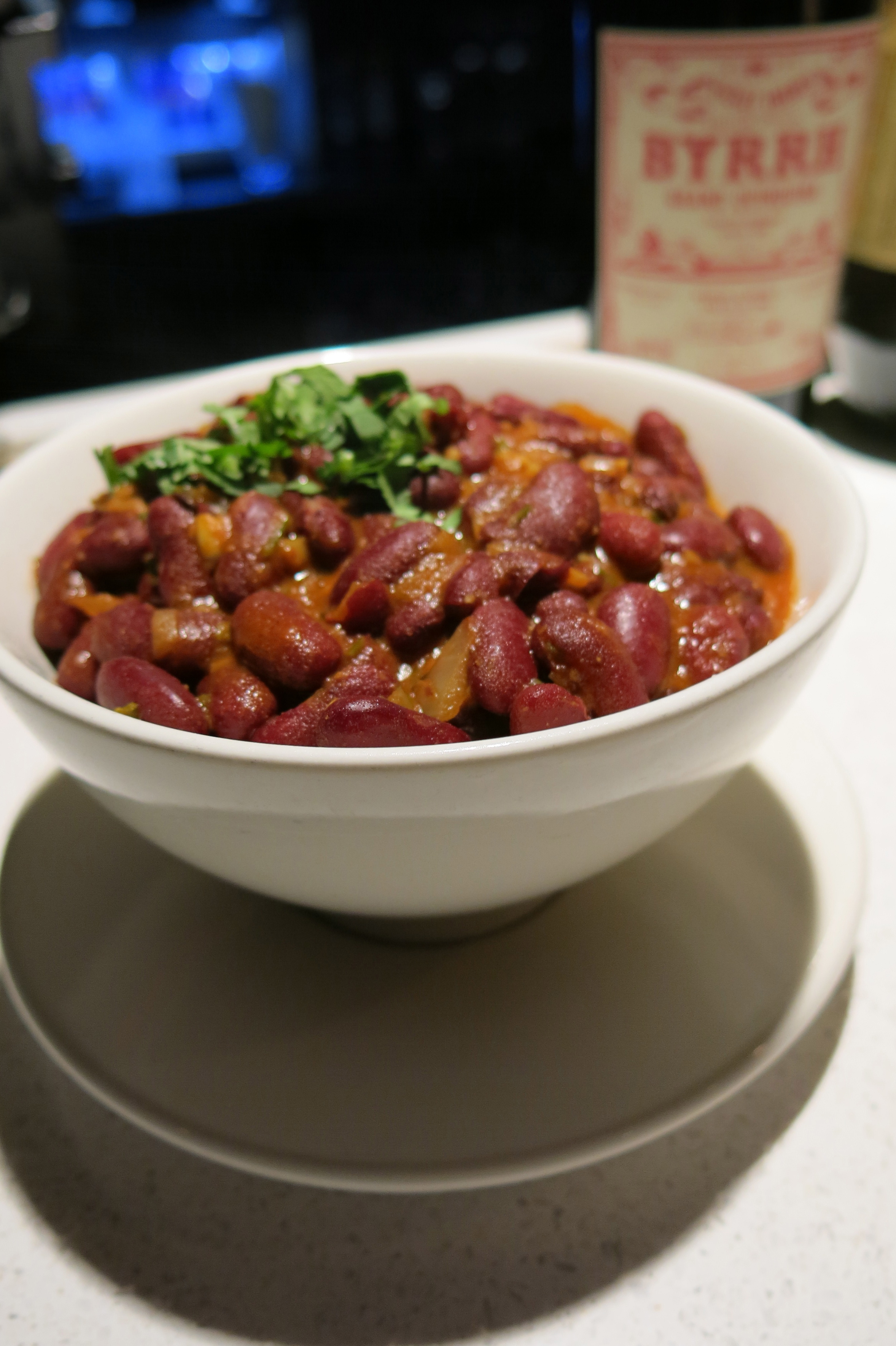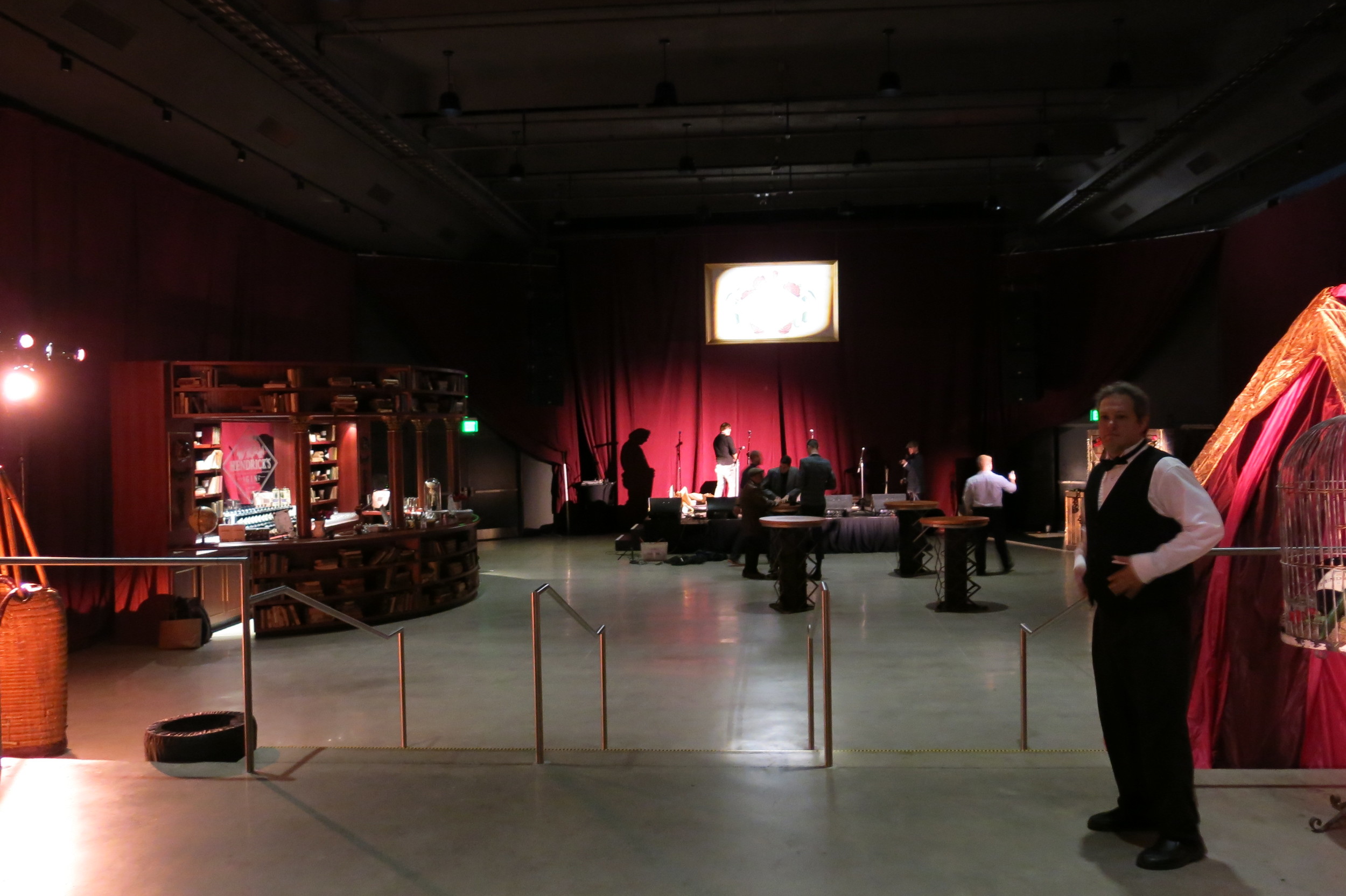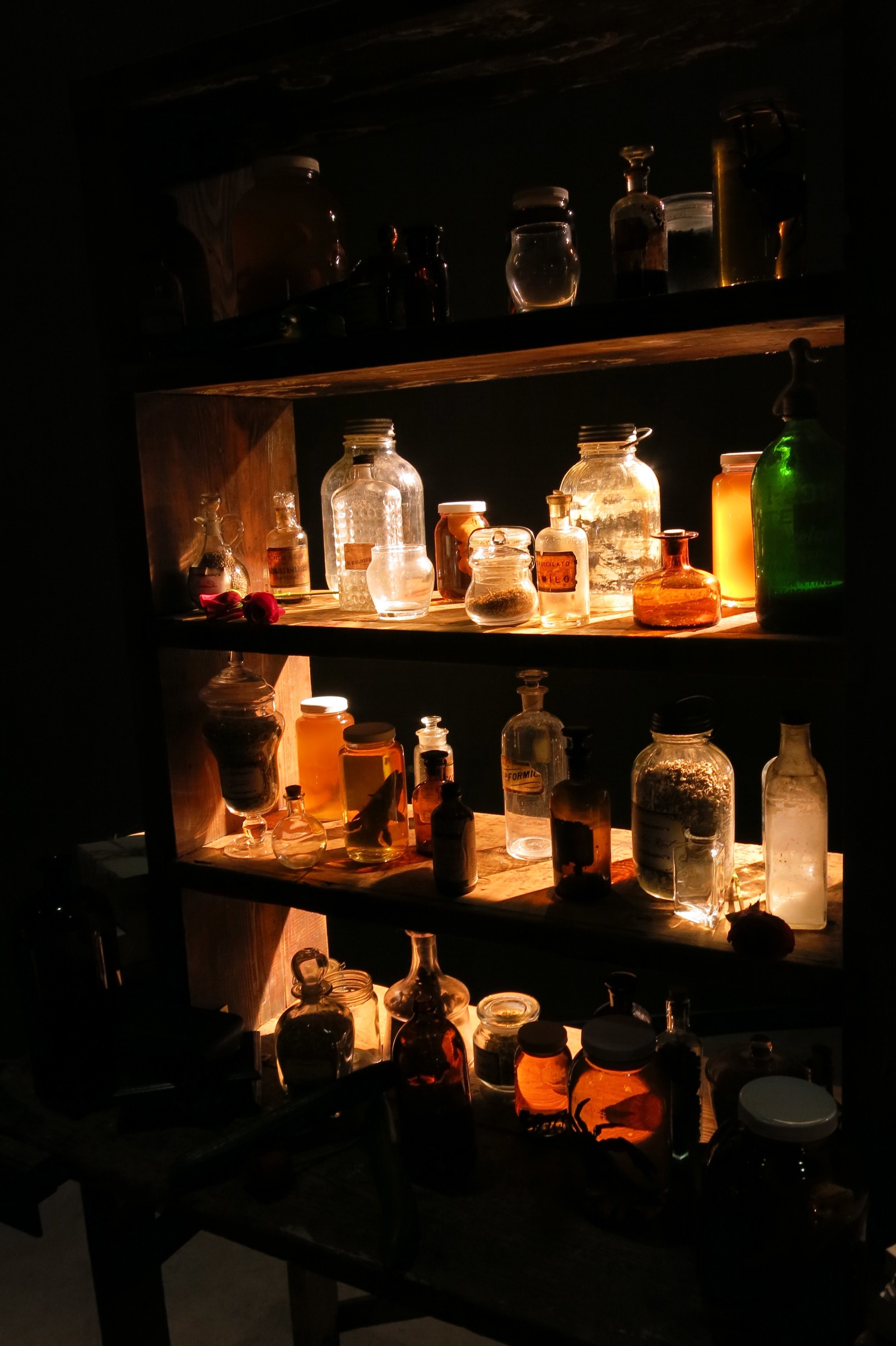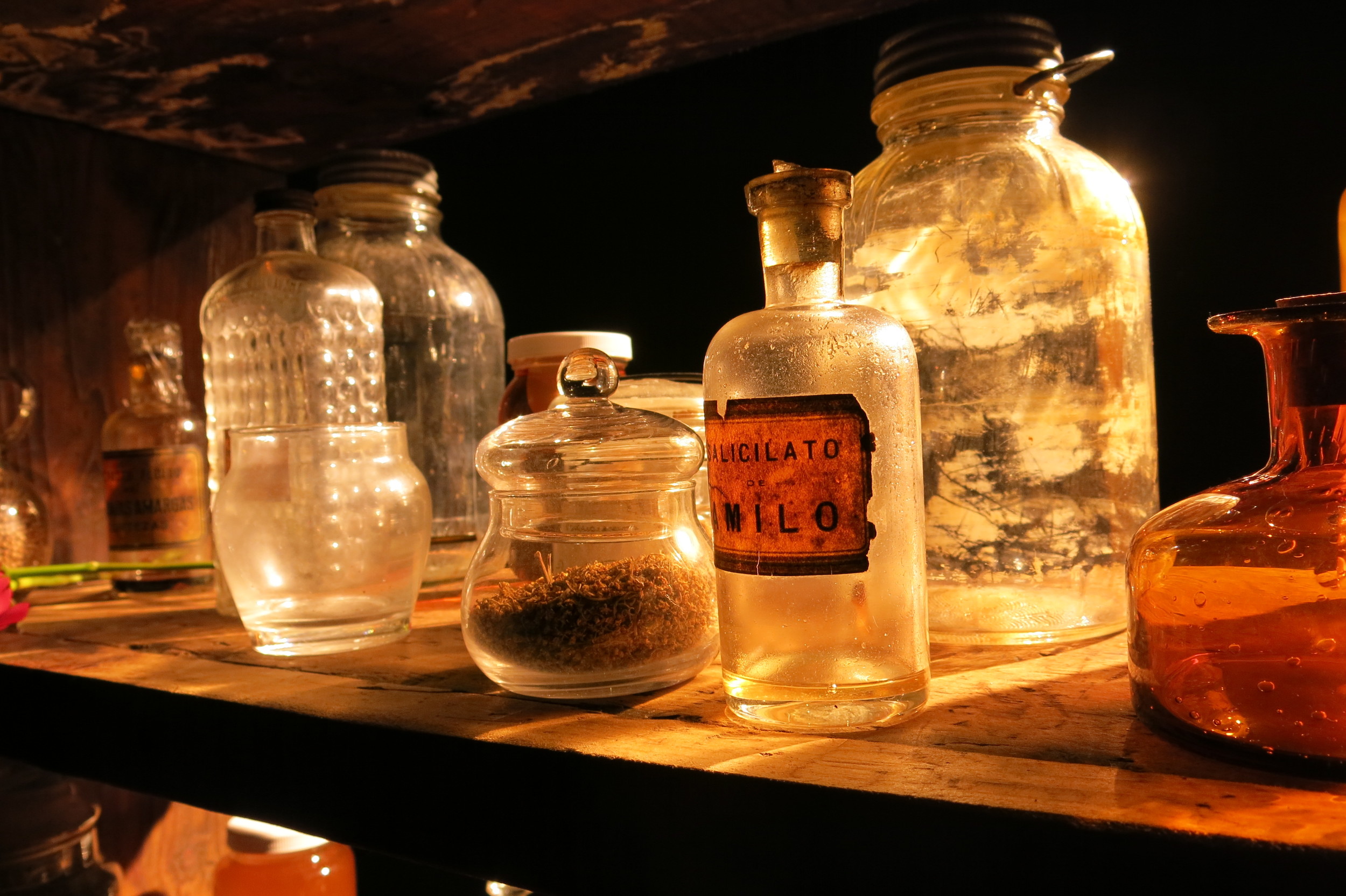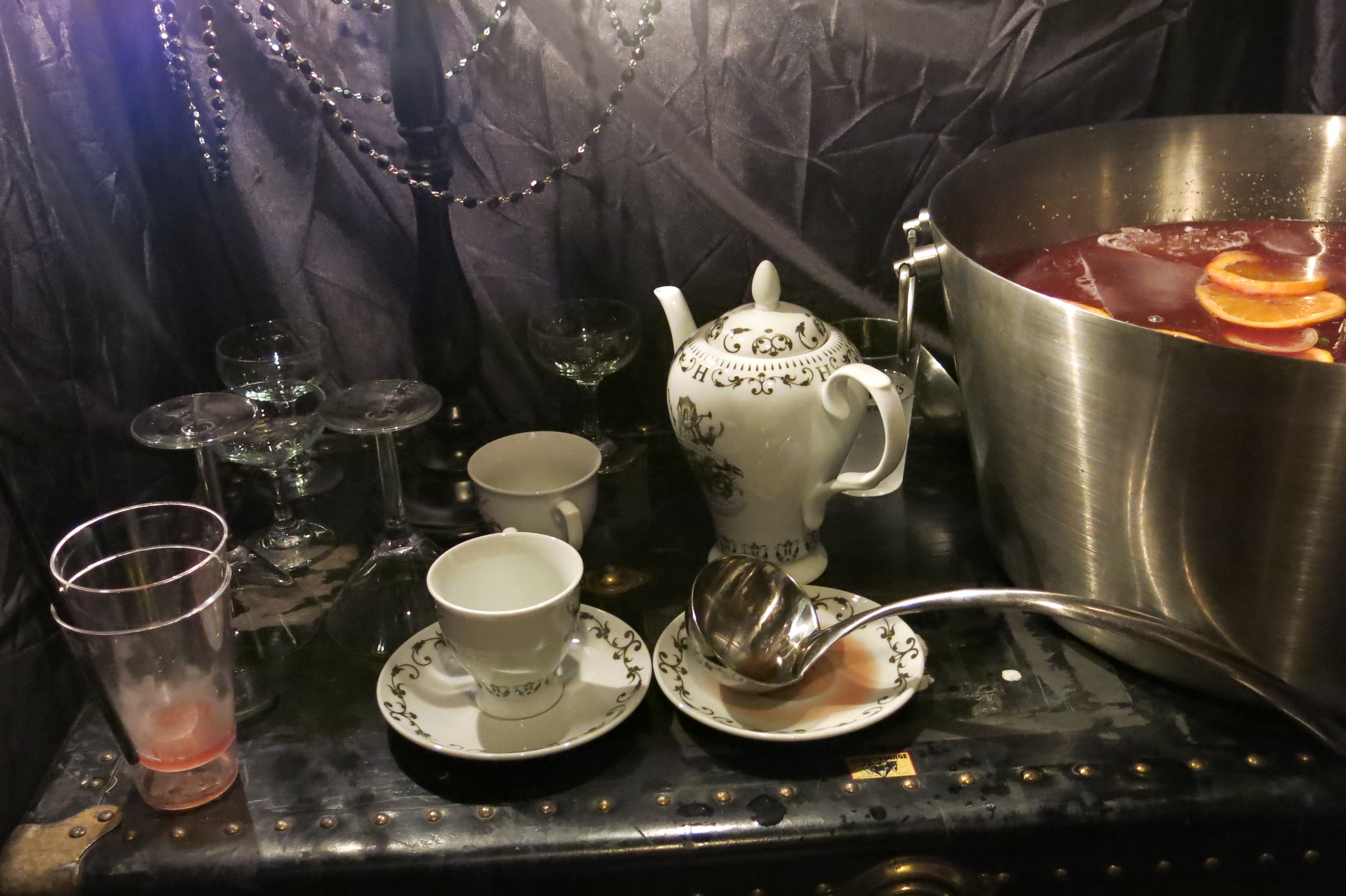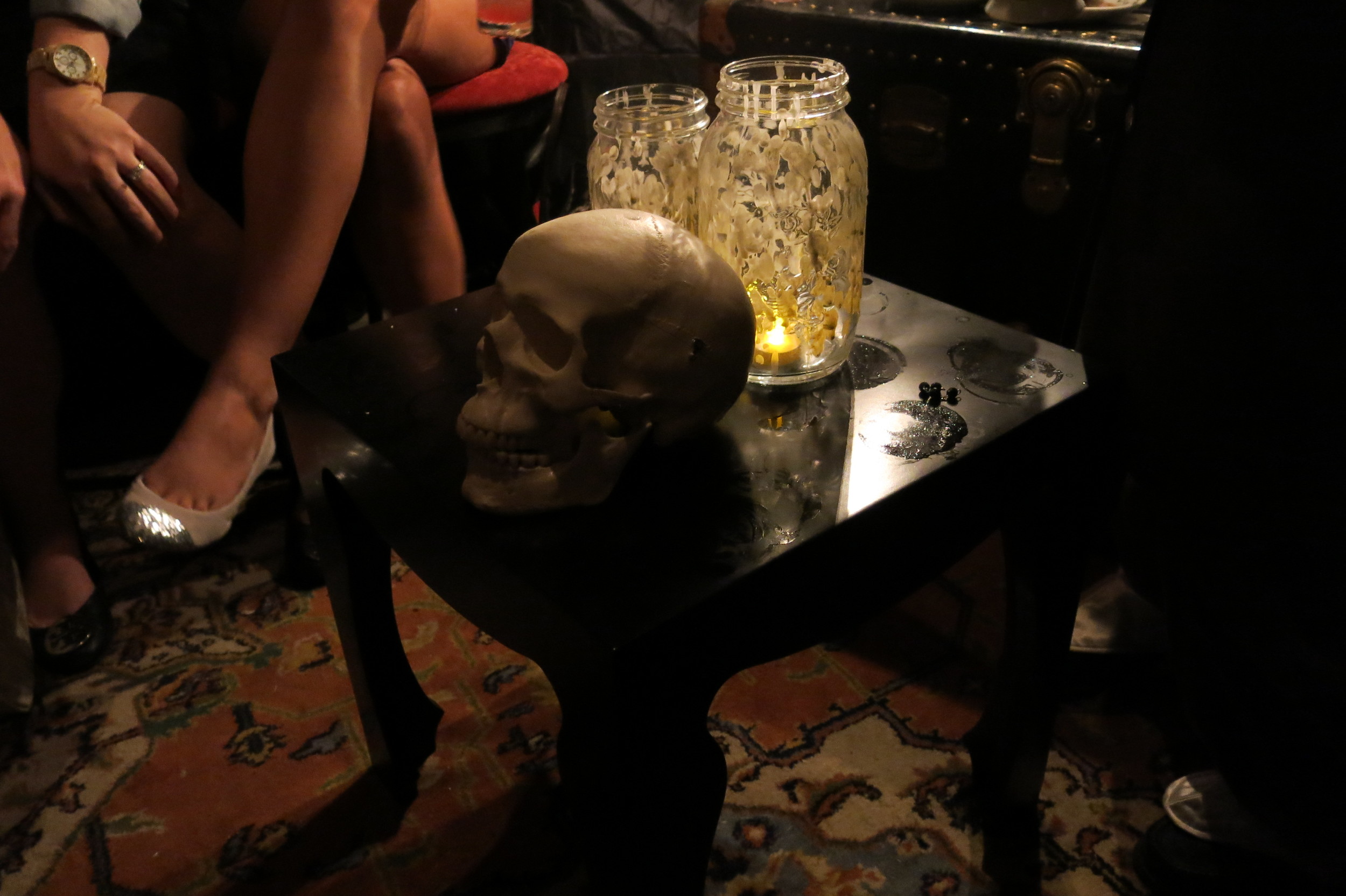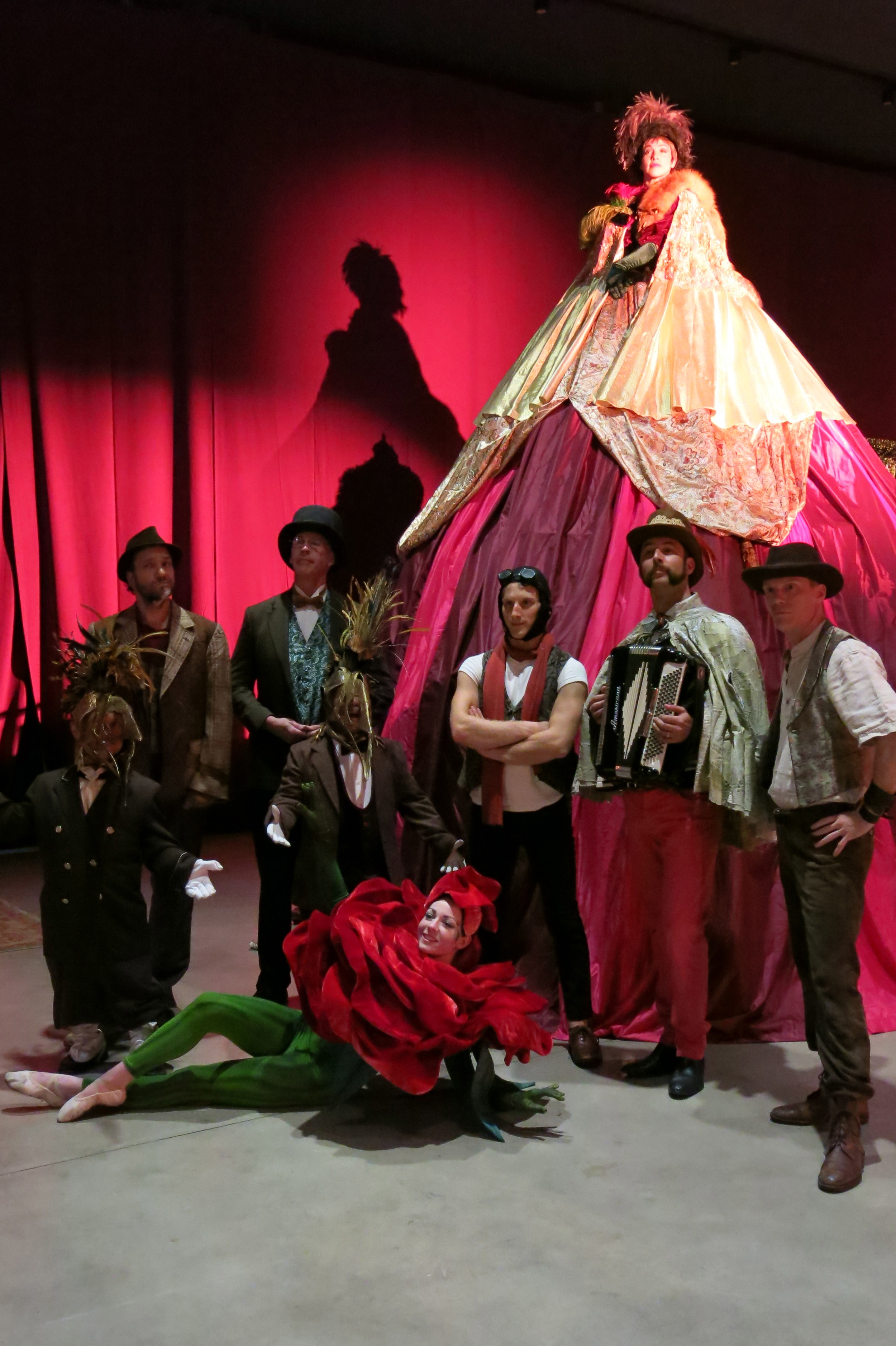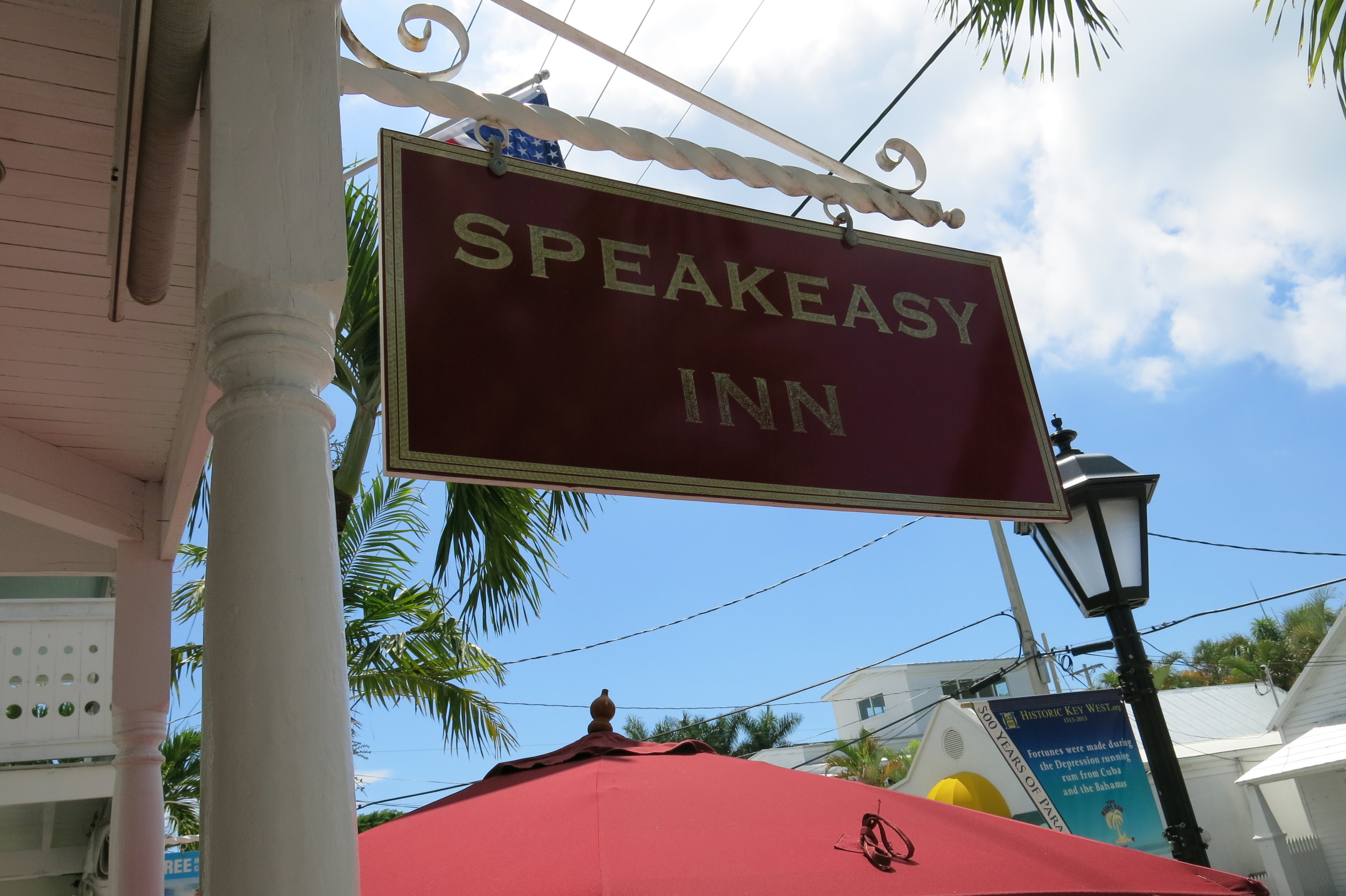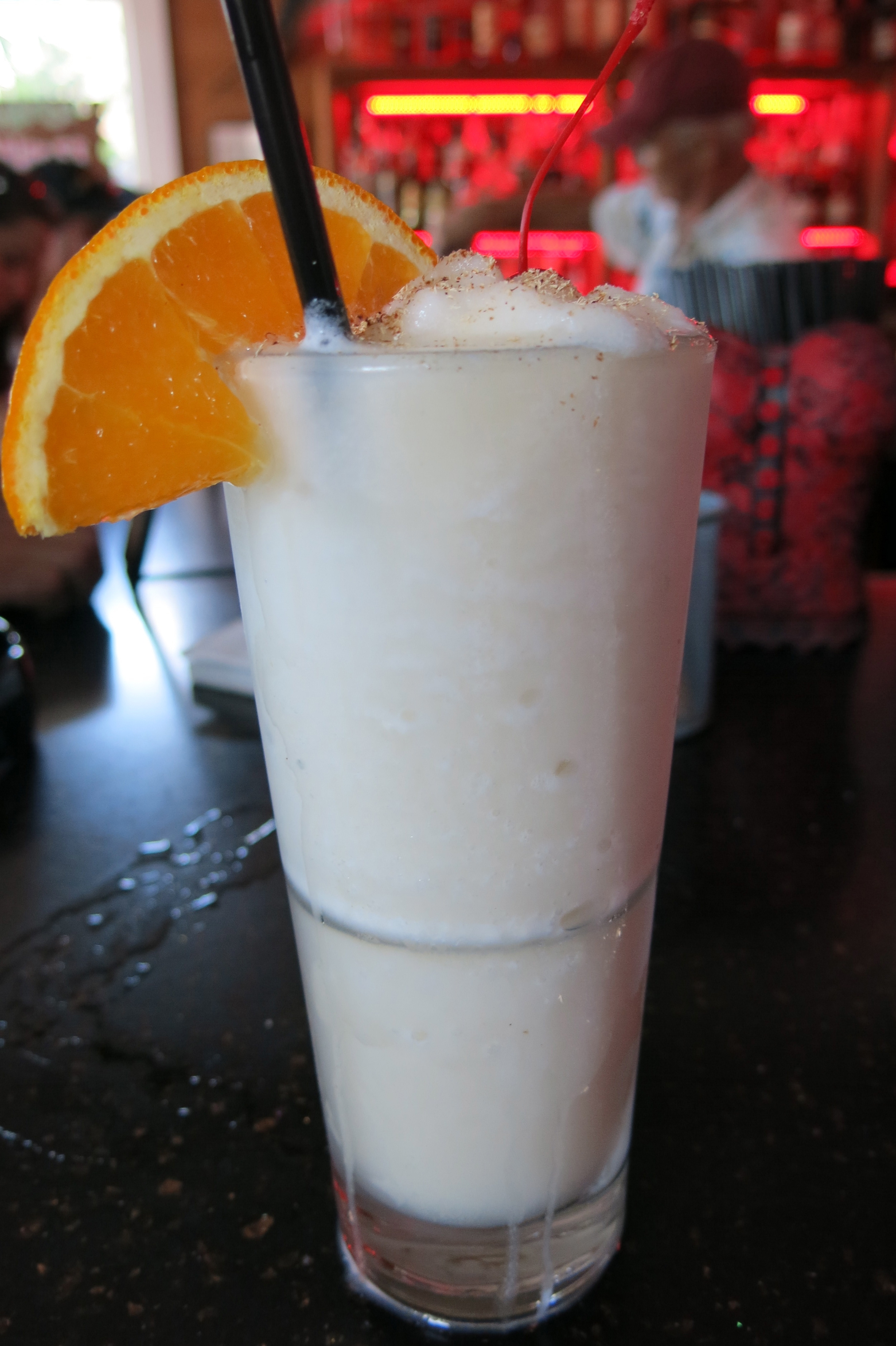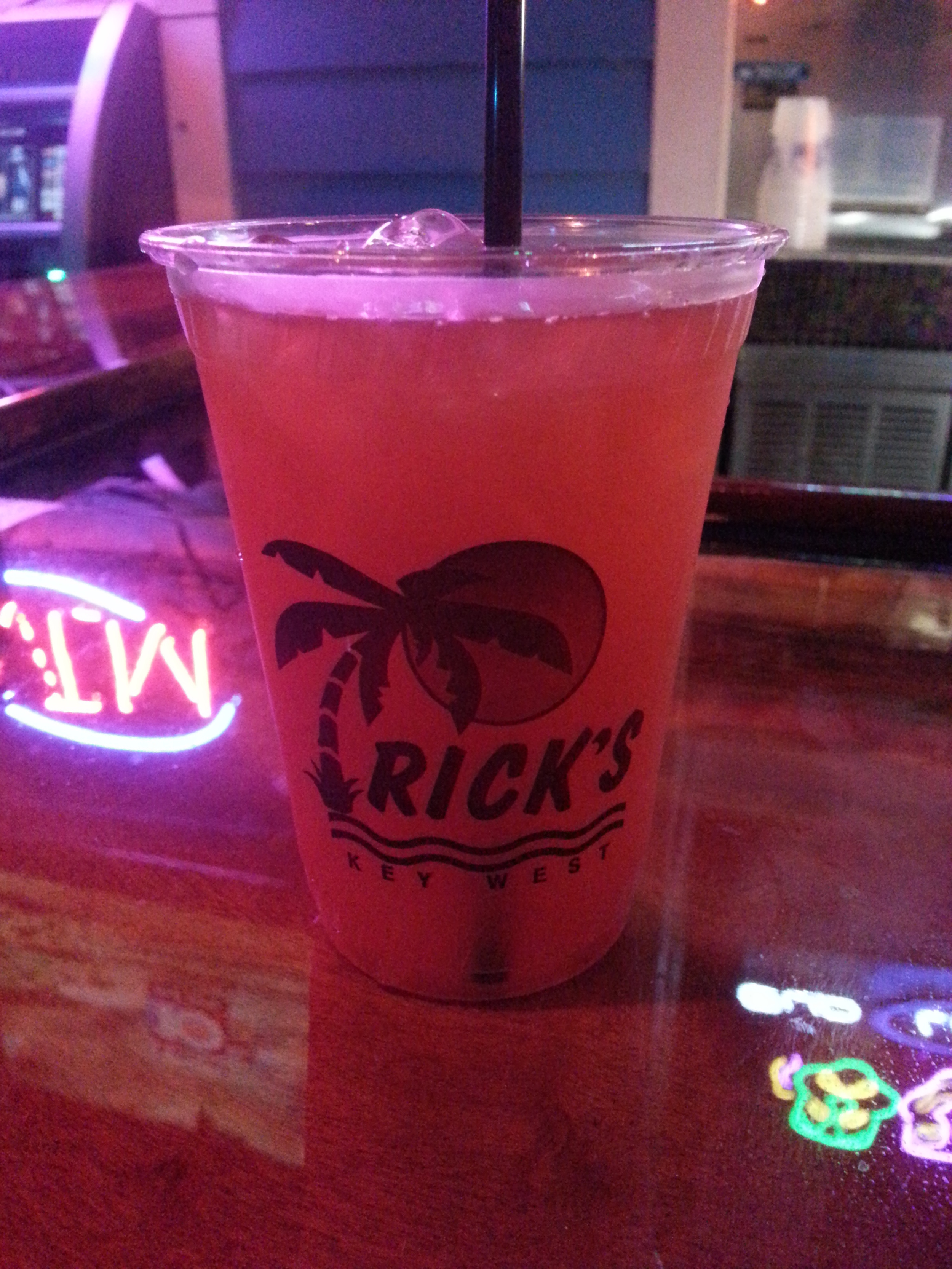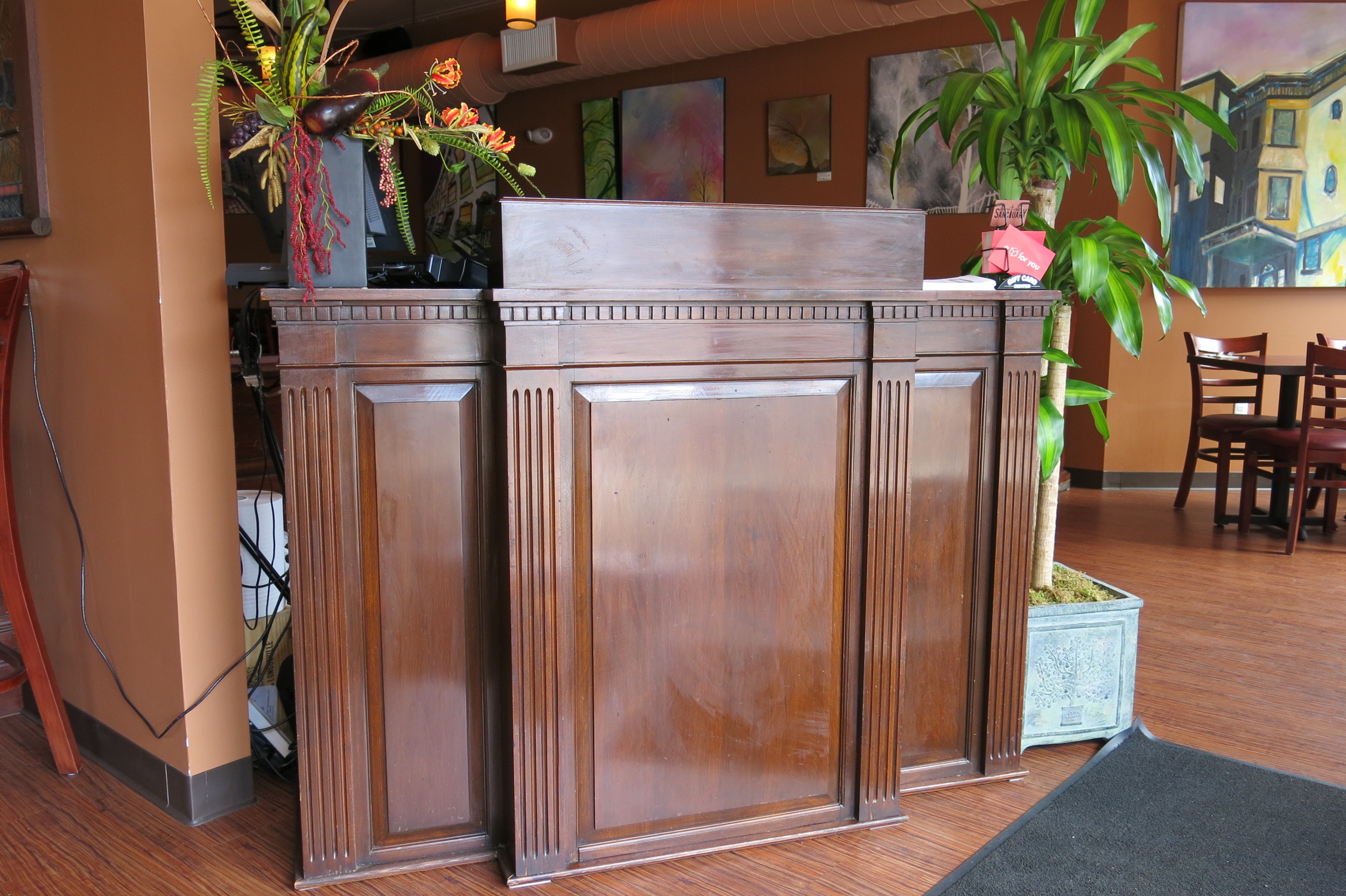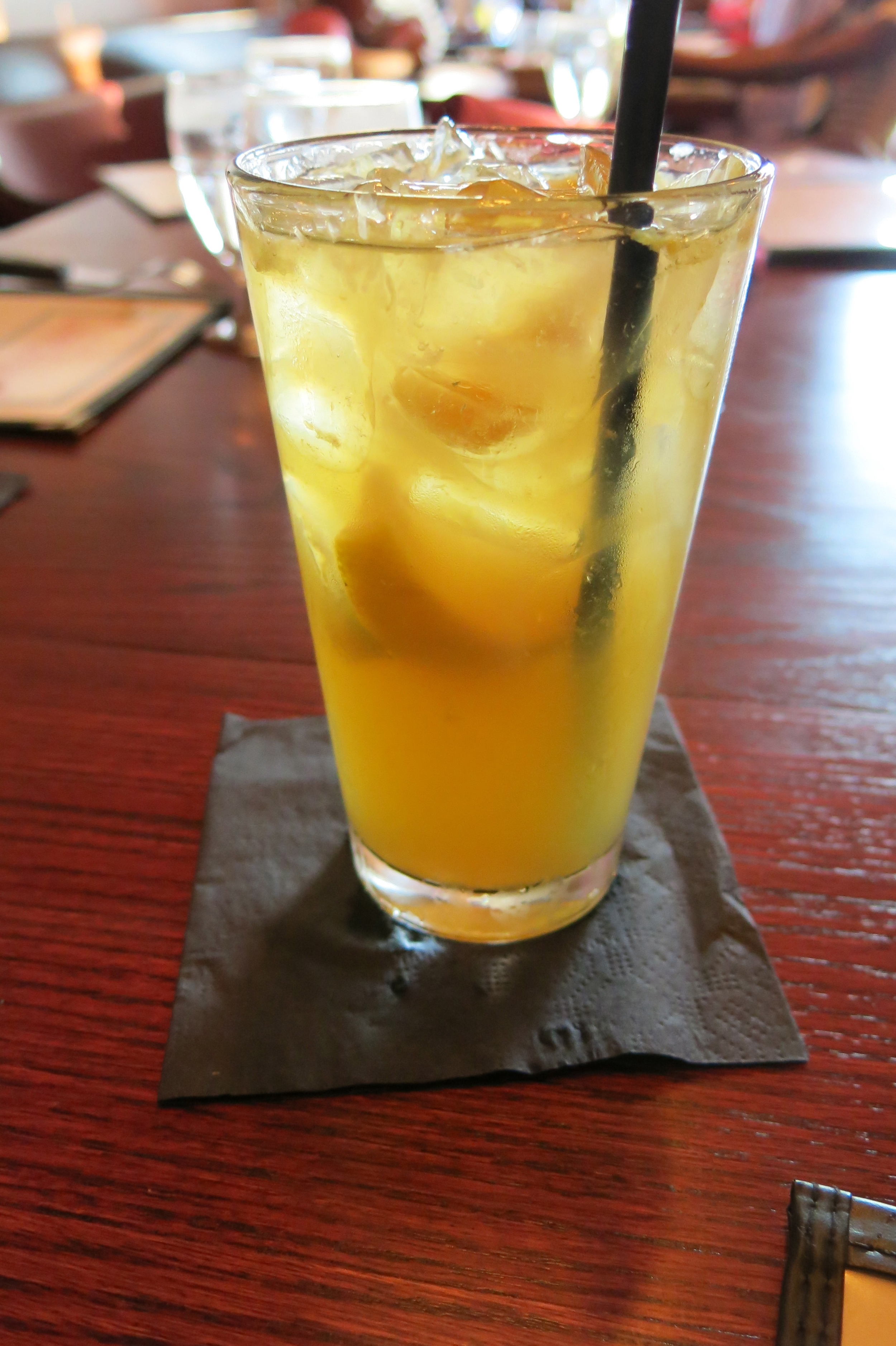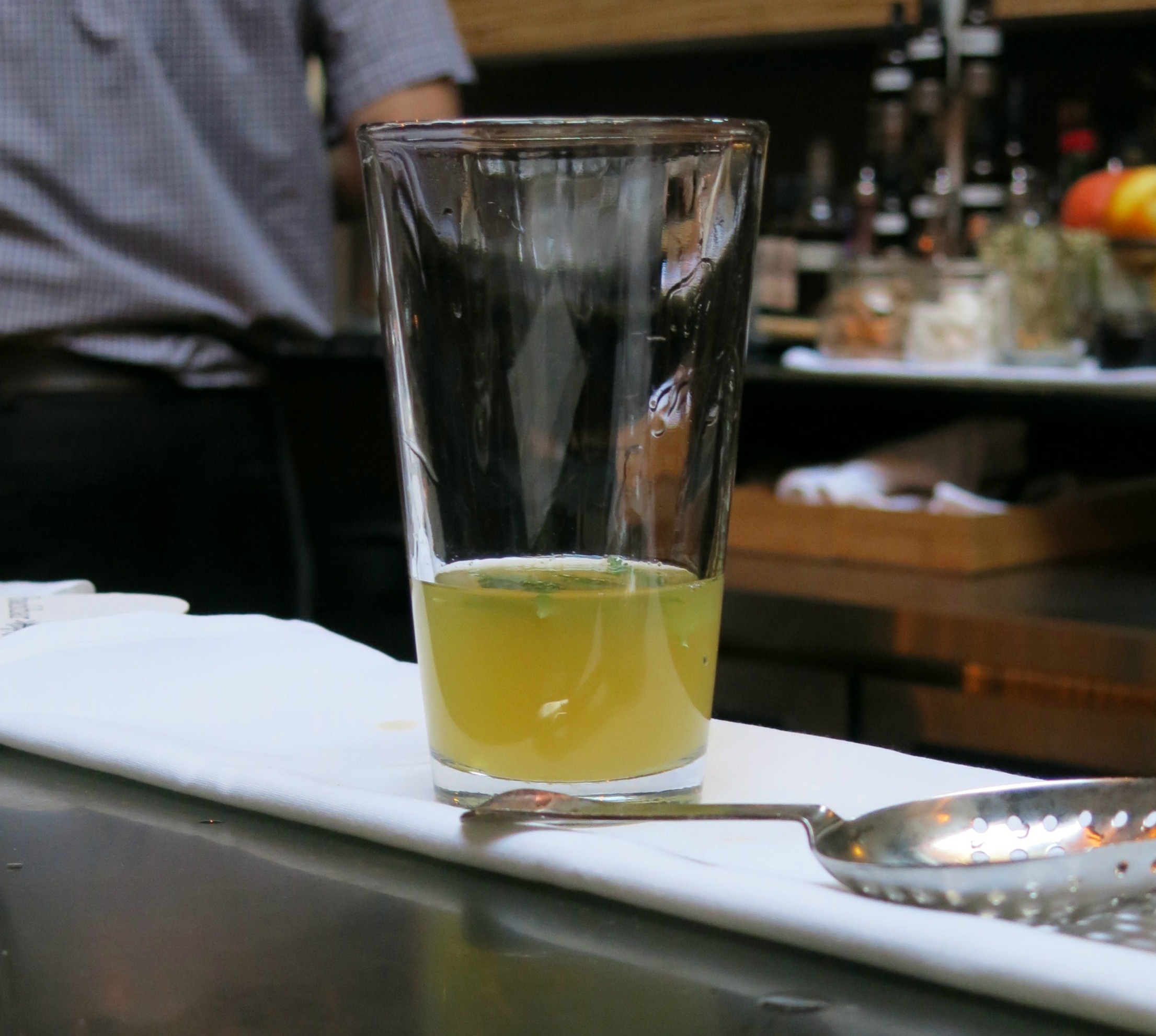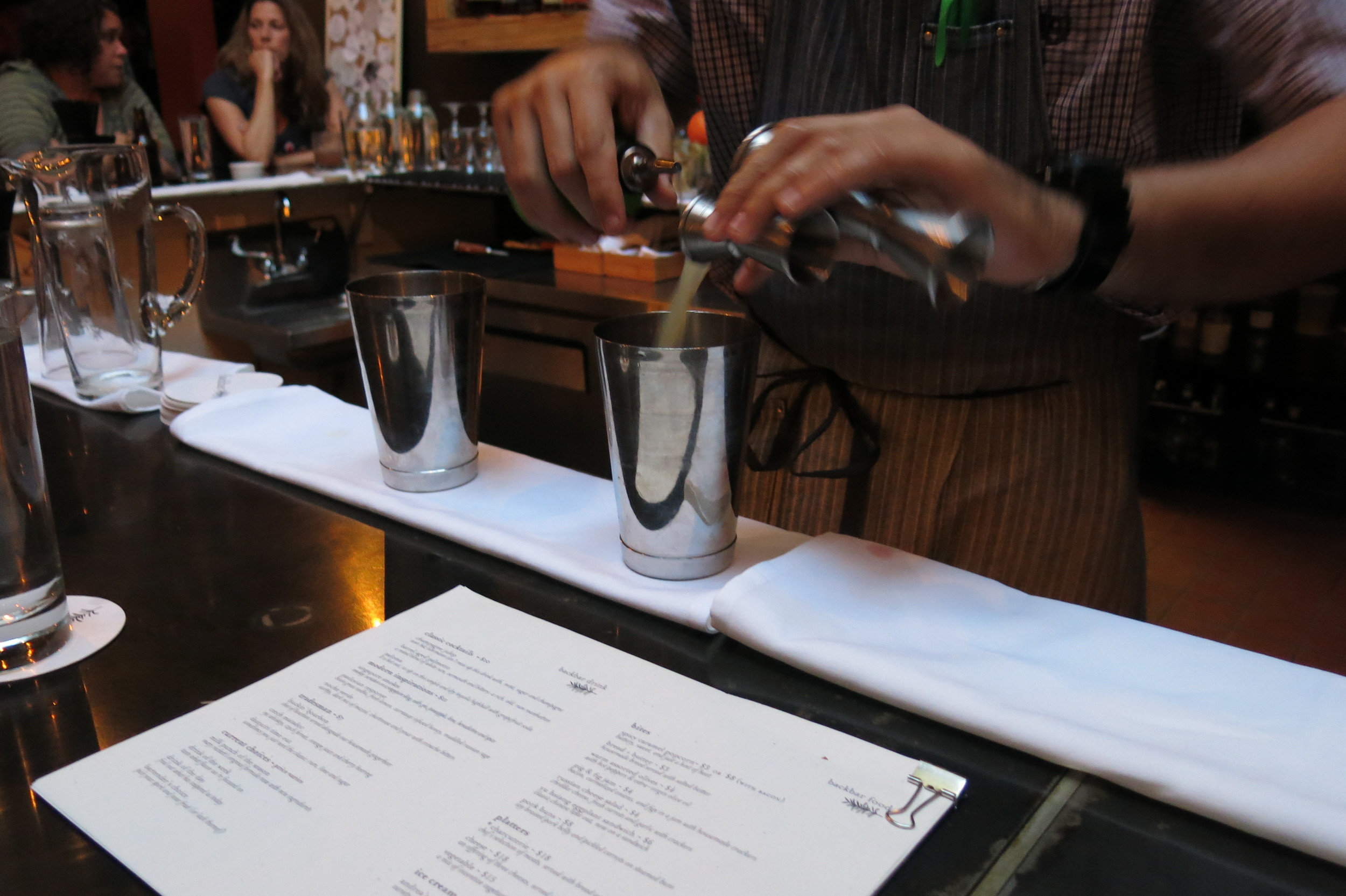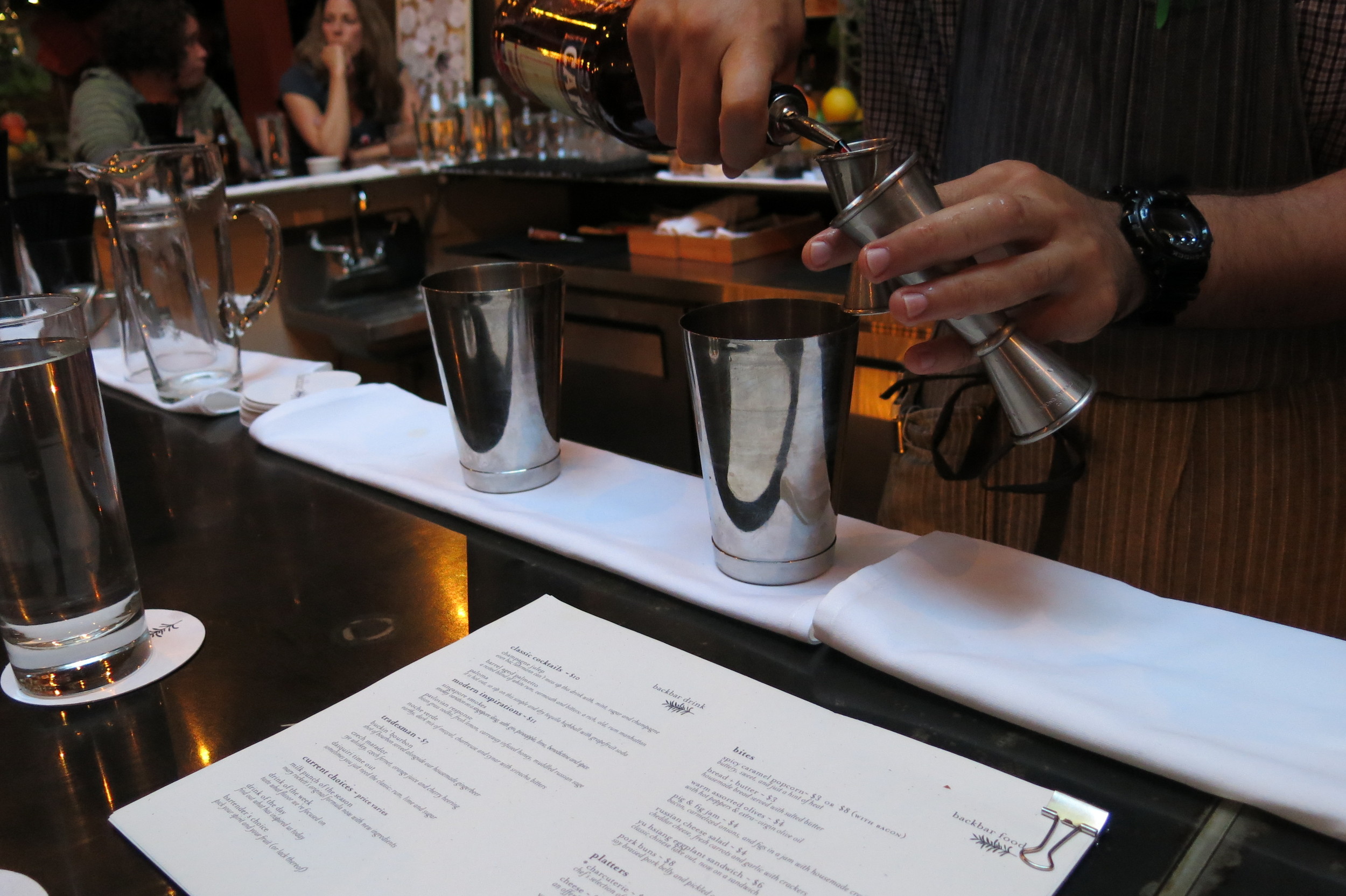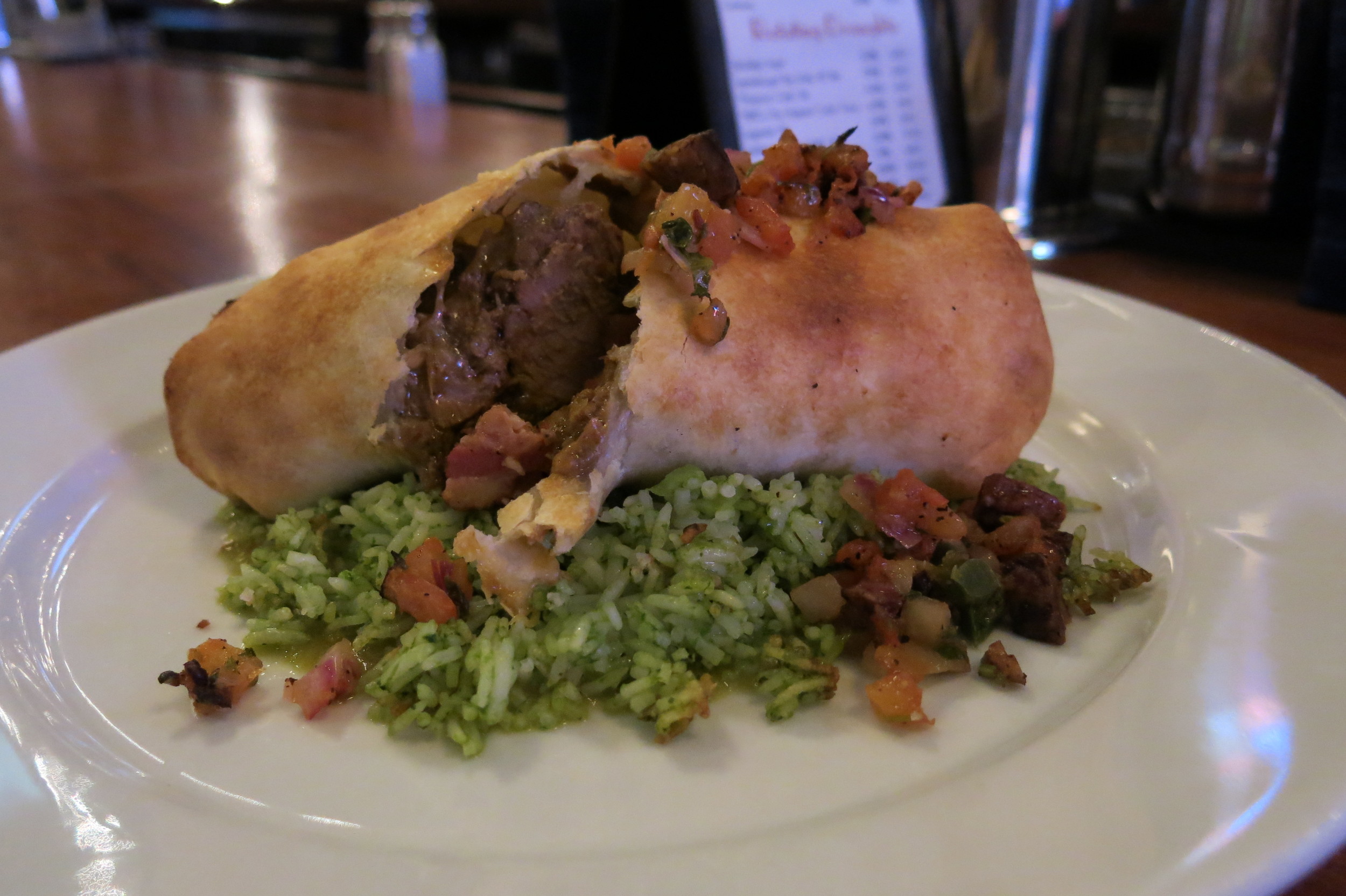Since last fall, Wink & Nod has been the subject of anticipation and speculation, with local media, industry onlookers, and would-be guests clamoring for closely guarded details about the South End bar and eatery’s cocktail offerings, décor, and food menu. After a pair of soft openings earlier this week, Wink & Nod finally opened its door to the public last night. Finding that door, however, might be a challenge unto itself.
Only the number of Wink & Nod’s Appleton Street address appears above the unmarked entryway to this speakeasy-style bar. Beyond the nondescript black door is a flight of stairs leading down to a well-appointed subterranean lounge. It is both a tribute to an era when discretion was essential and a celebration of the high-quality liquor and expertly crafted cocktails that were in exceedingly short supply during the dark days of Prohibition.
Oozing style and eschewing gimmickry, Wink & Nod infuses its high-end, contemporary décor with vintage accents. The upper half of the bi-level room comprises dinner tables and a living room-type area with comfortable leather chairs.
Dark, mahogany walls, black and tan carpeting, and table lamps conspire to create an intimate atmosphere, and soft music allows for conversation. Occupying the lower level is a 15-seat, wraparound bar with a smooth wooden surface and a layer of faux red snakeskin below. Funky chandeliers and a backlit liquor shelf cast a warm glow about the entire area.
Under the guidance of general manager and veteran mixologist Curtis McMillan, Wink & Nod’s cocktail program is second to none. The drink list, printed in an old-school typewritten font, is organized by type of spirit. Nearly all of the cocktails are named for Hollywood actresses, film characters, and socialites, like Joan Collins, Halle, and Vera Prescott.
They feature once-common ingredients like sherry, sloe gin, and egg whites, along with all the fashionable mixers that make modern craft cocktails so attractive, like house-made ginger beer, fresh herbs, and wonderfully flavored bitters.
And every drink starts with a top-notch spirit – a point Curtis insists on after seeing how many bars use low-quality liquors even in high-priced drinks. “I just couldn’t sleep at night if we did that,” he says. “That’s why our well liquors are all micro. Berkshire Mountain bourbon, GrandTen, Bully Boy makes our vodka,” he says, rattling off an impressive list of Massachusetts distilleries.
That dedication to quality – along with some quick thinking – was on display in Tuesday evening’s featured cocktail, the Basil Bourbon Smash. “We ordered two pounds of mint from our supplier,” Curtis says. “When it arrived, we opened it up, and it was all basil. I said, I can work with this.” He did better than just work with it. The fresh aroma of basil and lemon preceded every sip.
It’s the sort of ingenuity that permeates the entire cocktail program. And despite Curtis’s renowned mixology skills, he employs no bar manager and leaves much of the cocktail design to his staff. “Each bartender designed a drink; their baby,” he tells me, adding “if their drink is the best-seller for a quarter, they get to pick their shift.”
That may lead to some friendly competition among the staff, but the clear winners are those of us on the other side of the bar. The Raquel, for instance, is the brainchild of Rich Fiorillo, late of Church. It combines Mount Gay Old rum, Monkey Shoulder scotch, freshly pressed apple juice, orgeat syrup, and Gran Classico. Served in a funky tiki mug, it’s a sweet cocktail with a pronounced apple flavor that’s well balanced by the scotch and the bitter Gran Classico.
The Cattrall is an even bolder blend of flavors – Montelobos mezcal, Cocchi Americano, a grapefruit cordial, fresh lime juice, and prosecco. Because the smokiness of the mezcal is so distinctive, it can be a challenging spirit to work with. Fortunately, Curtis knows a thing or two about mezcal, and the resulting cocktail is extraordinary. The smoky flavor is unmistakable but doesn’t overpower the drink, enabling the bitter, sour, and citrusy components to shine. The prosecco provides some effervescence and a little dryness.
Bartender Jason Rykiel, another Church alum, says that he found the recipe for what would become the Madonna in an old tiki cocktail book. This creamy mix of Plymouth gin, sloe gin, simple syrup, dry curacao, and egg white is smooth, sweet, and fruity, with a thick layer of foam on top.
There’s even a selection of “Shooters,” and while shots are typically just a quick and easy way to tie one on, they aren’t exempt from Wink & Nod’s high standards. The surprisingly complex Sharknado combines cranberry liqueur, fresh pineapple, blue curacao, orange bitters, and Notch Session Ale. You can throw that down in one big gulp if you so desire, but like everything else on the drink list, you’d be better served by taking it slow and appreciating the composition.
It was long considered a given that Wink & Nod would be serving exceptional craft cocktails. For months, though, the dinner menu was afforded all the secrecy of a speakeasy password. When finally unveiled, it was something of a bombshell – the menu would be handled by pop-up restaurant Whisk.
For the past several years, Whisk chefs Philip Kruta and Jeremey Kean have been showing up in restaurant kitchens throughout Boston, impressing chefs and foodies alike with their experimental but approachable recipes and use of local ingredients. They agreed to take up a permanent residence at Wink & Nod, so long as they maintained final say over their avant-garde fare. They remain independent, and the kitchen is called Whisk at Wink & Nod.
With Whisk at the helm, even the simplest of recipes are deftly handled in unexpected ways, like warm bar nuts topped with candy garlic, cilantro, and nuac cham (a Vietnamese dipping sauce).
The artfully presented scarlet butter lettuce, with stilton cheese and a farm egg, is far from your traditional salad.
Served in a miniature cast-iron skillet on a wooden board, the duck meatballs with foie gras may be the high point of the small bite menu. With black garlic and pickled blueberry on the side, they’re delicious and bursting with flavor.
But the real showstoppers are the Yakitori “in-smoke” offerings. While my words and pictures can scarcely do this dish justice, here’s how it works. Your choice of quail, short rib, or pork belly (I opted for the last) has been marinated overnight in a soy sauce blended with all manner of spicy goodness. Your skewered meat arrives at your table in a mason jar filled with smoke.
Take a good minute and enjoy the fact that you’ve got a jar of smoke in front of you, then open the lid, whereby you’ll release a plume of aromatic smoke that reaches to the ceiling.
Enjoy your brief celebrity status while everyone around you turns to gawk at the spectacle and remark on the heavenly scent of the cherry wood smoke. And the meat more than lives up to its unique presentation. The confit pork belly is fall-apart tender, and small pickled apples contribute a bit of acidic tartness.
Curtis expressed genuine disappointment that I was forgoing the signature dessert – a homemade Twinkie filled with brown butter cream – but I couldn’t resist one more cocktail. I asked Jason to recommend something, and he responded with one of his own recipes. The Susan is a mix of Brugal 1888 rum, Brugal Silver rum, Averna, simple syrup, and strawberries. In a word? Phenomenal.
I tend to think of strawberry-based cocktails as light, sweet, and unremarkable (daiquiris, margaritas, the sort of drink you sip by the pool on a summer day). The Susan, by contrast, has tremendous depth and complexity. Brugal 1888 is a serious rum aged in whiskey barrels, and the bitterness of the Averna keeps the sweetness in check. The result is a rich, balanced cocktail with a fresh, natural strawberry flavor profile. And it’s been in the works for some time. “It was a recipe I was working on at Church, but I could never get it right,” Jason says. “Even when I tried it here, something was missing. It went right down to the wire. Then the other day I turned around [to the bar], saw some black walnut bitters, and tried them. That did it.”
Whether it’s black walnut bitters to the rescue or a mint-based cocktail improvised with basil, it’s clear that the culture at Wink & Nod fosters experimentation but demands excellence. And that’s only fitting for a bar that honors the classic approach to making a good drink.
Last Call
Wink & Nod draws its name from a quote famously attributed to long-time Boston politician Martin M. Lomasney: “Never write if you can speak; never speak if you can nod; never nod if you can wink.” Sage advice on the topic of discretion from the legendary boss of Ward 8, and a prudent way to communicate about an illicit watering hole. But everything’s above the table at this below-ground bar, so you needn’t be concerned about a liquor raid. Nor do you have to worry about it being campy or high-concept; Wink & Nod is refreshingly original and devoid of Prohibition clichés. The unmarked door and the lack of windows give it a speakeasy vibe, but the elegant décor and outstanding drinks recall the golden age of cocktails, when making a drink was an art and a night of fine dining was a glamorous affair.
Although Tuesday was Wink & Nod’s first night with a crowd, everything seemed to be humming along pretty smoothly. Curtis roamed from table to table and throughout the bar area, checking on customers, telling stories, and getting people’s impressions. Service was excellent, and with three or four bartenders operating at any given time, there was never a long wait for a drink.
Speaking of long waits, Wink & Nod has been on the local radar since last October. Without question, it’s worth the wait. And while there’s no neon sign trumpeting its arrival, chances are the door will be easy to spot when there’s a line snaking around the block.
Address: 3 Appleton Street, Boston
Website:http://www.winkandnod.com/
* * * * * * * * * * * * *
Copyright © Boston BarHopper. All Rights Reserved.








